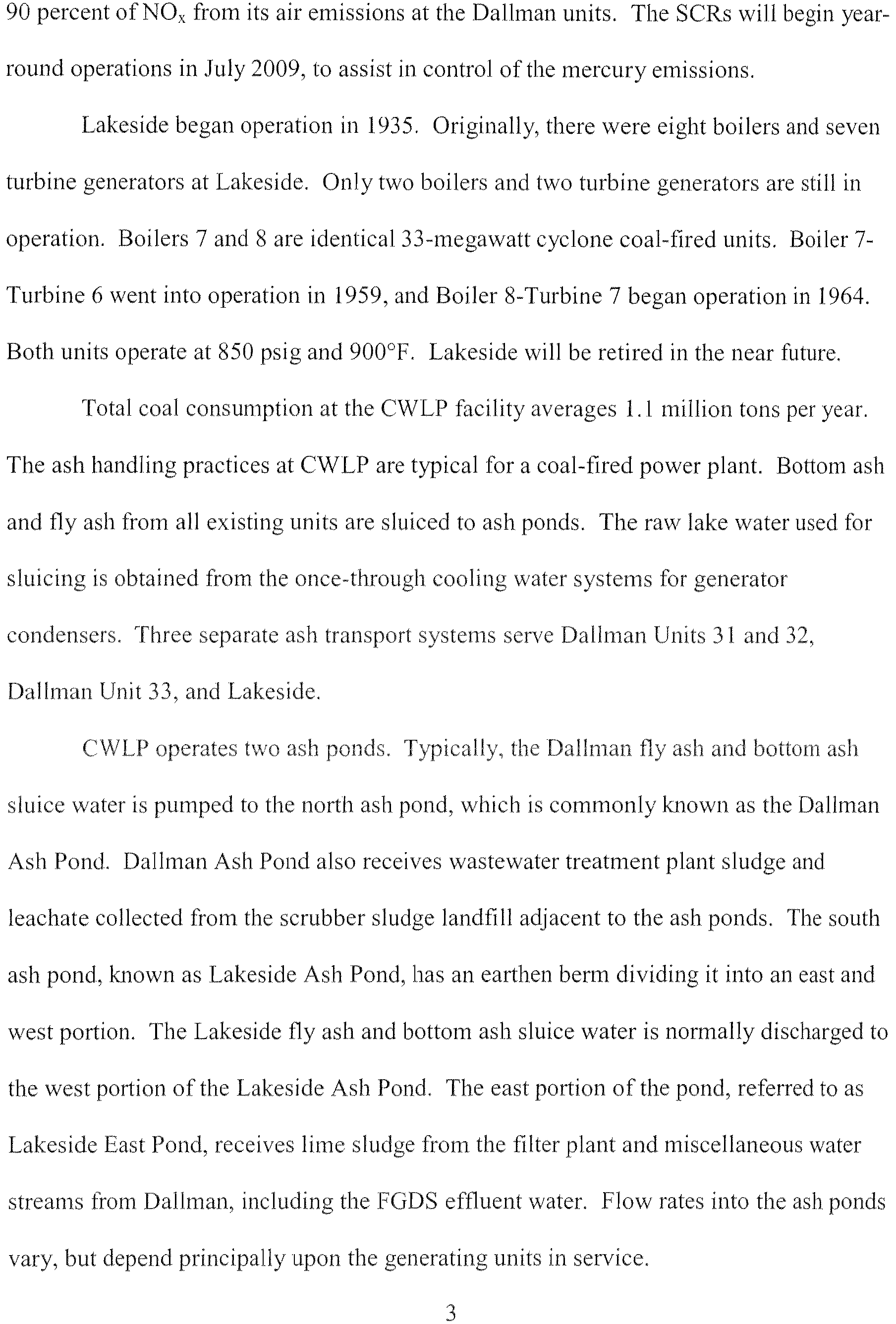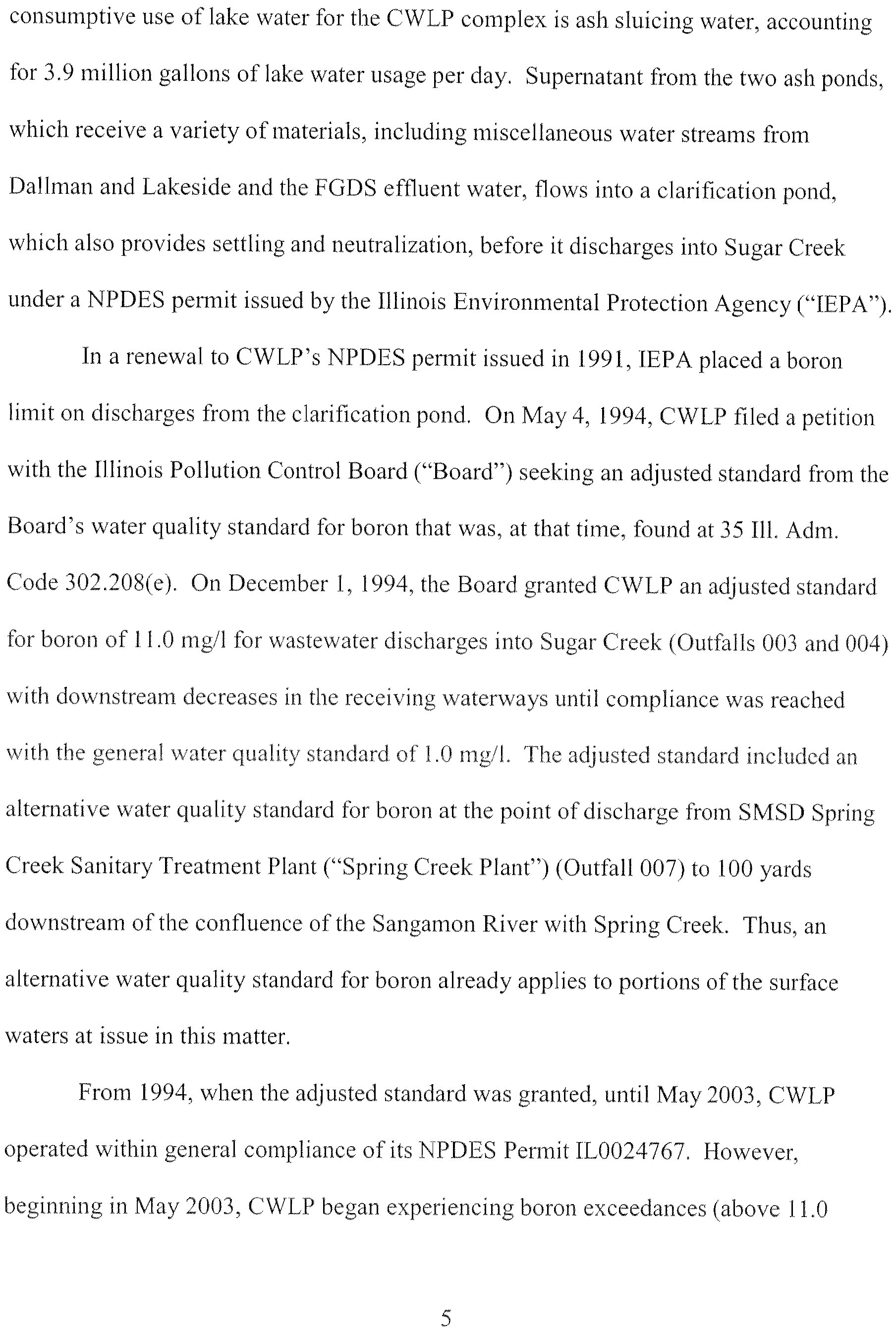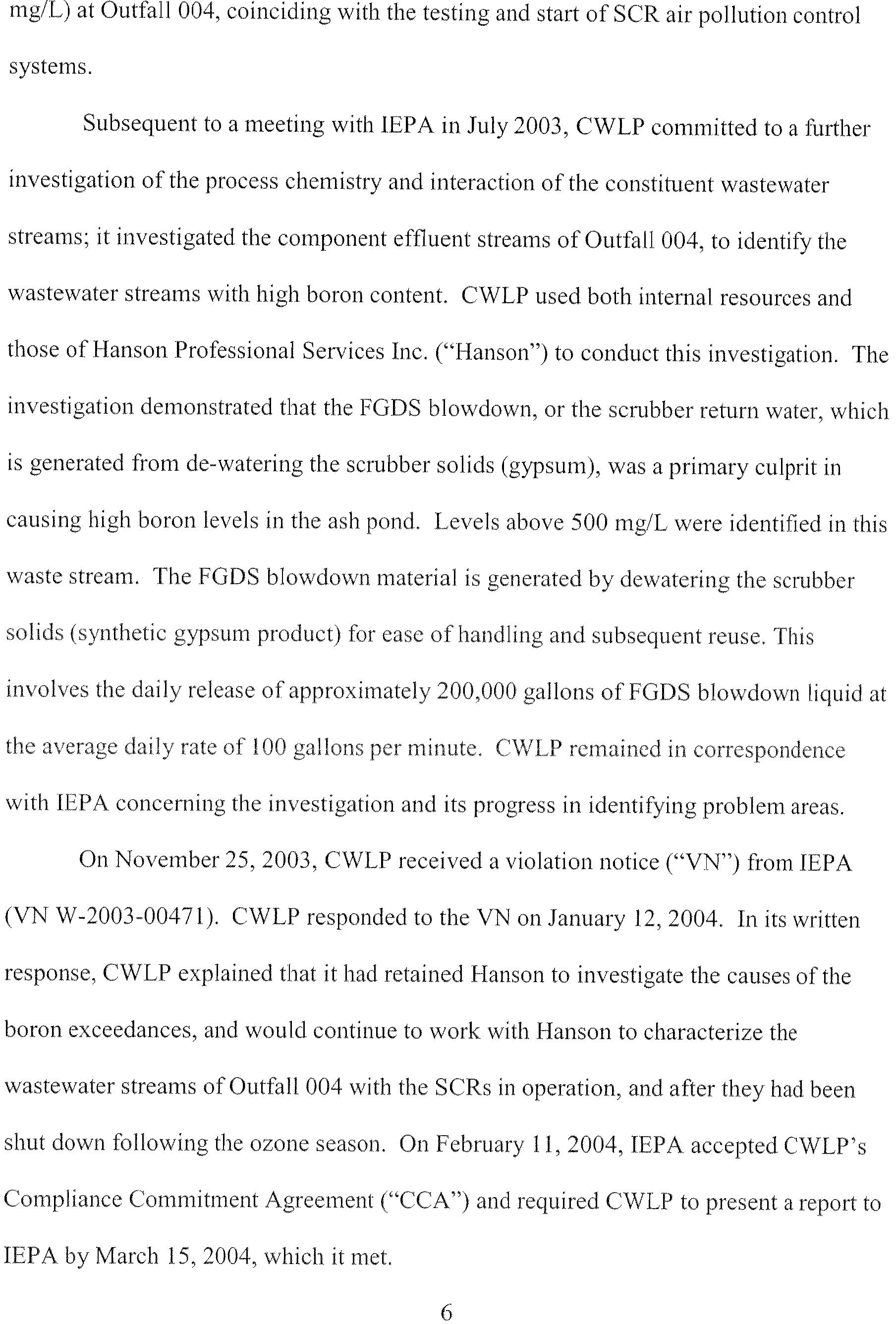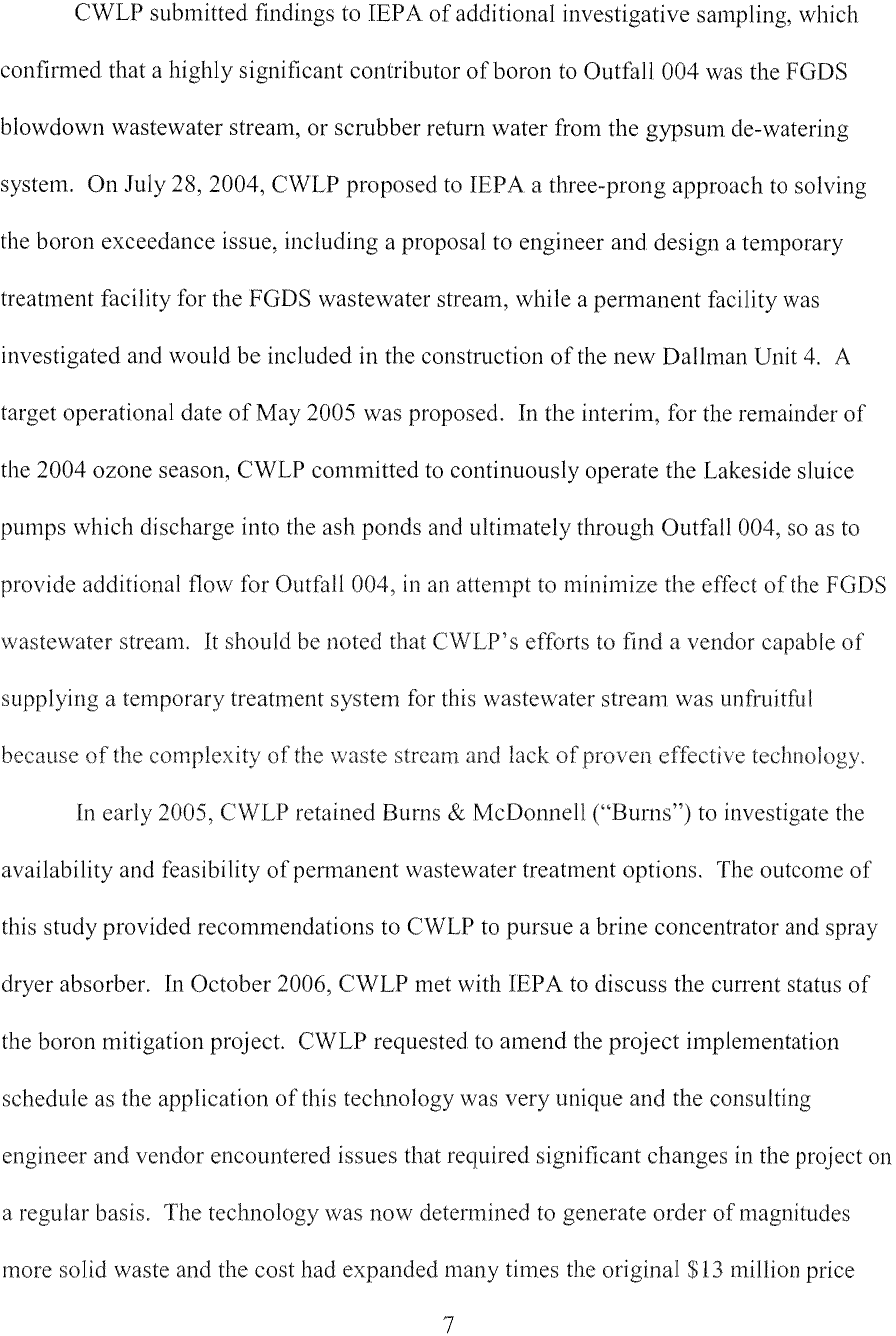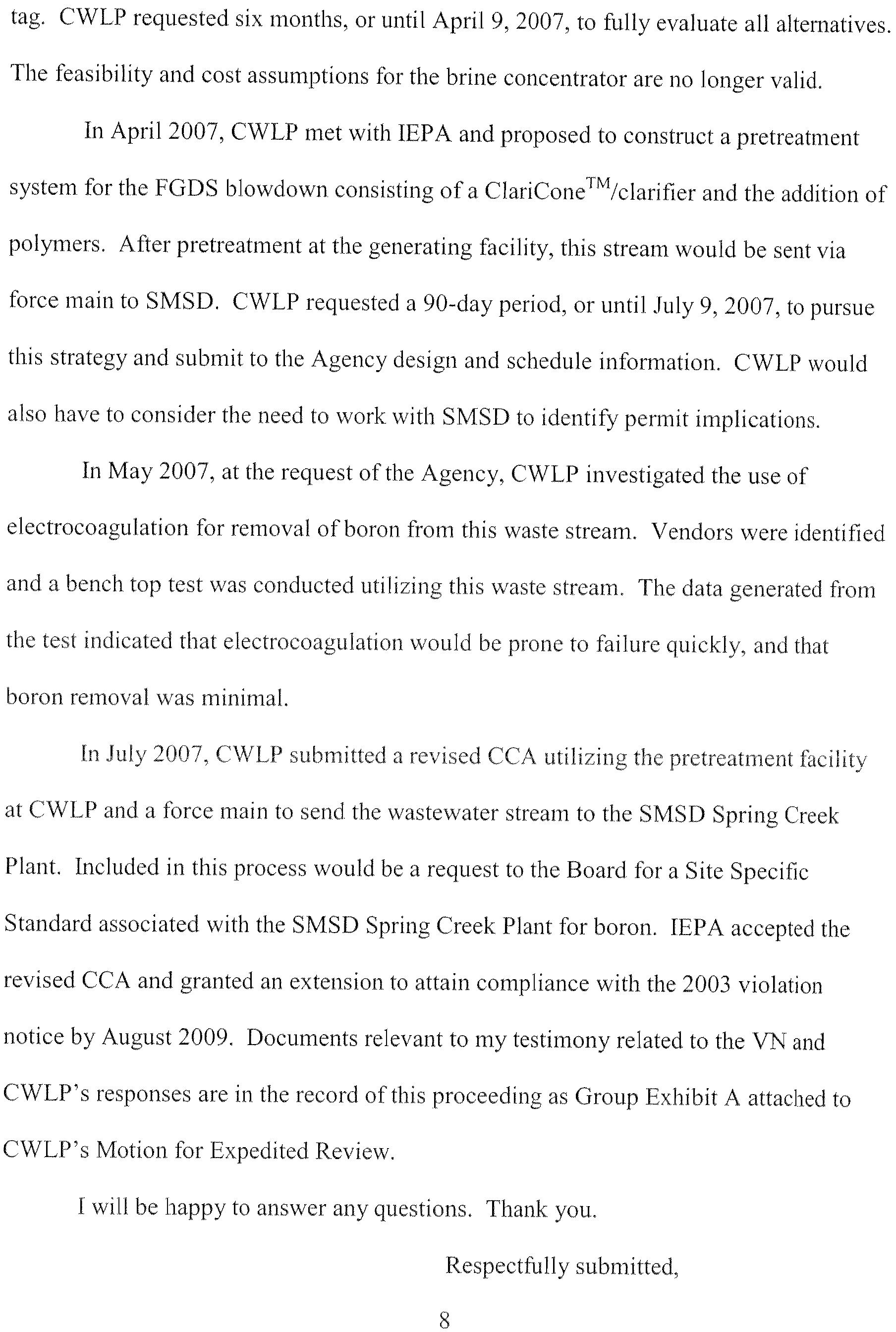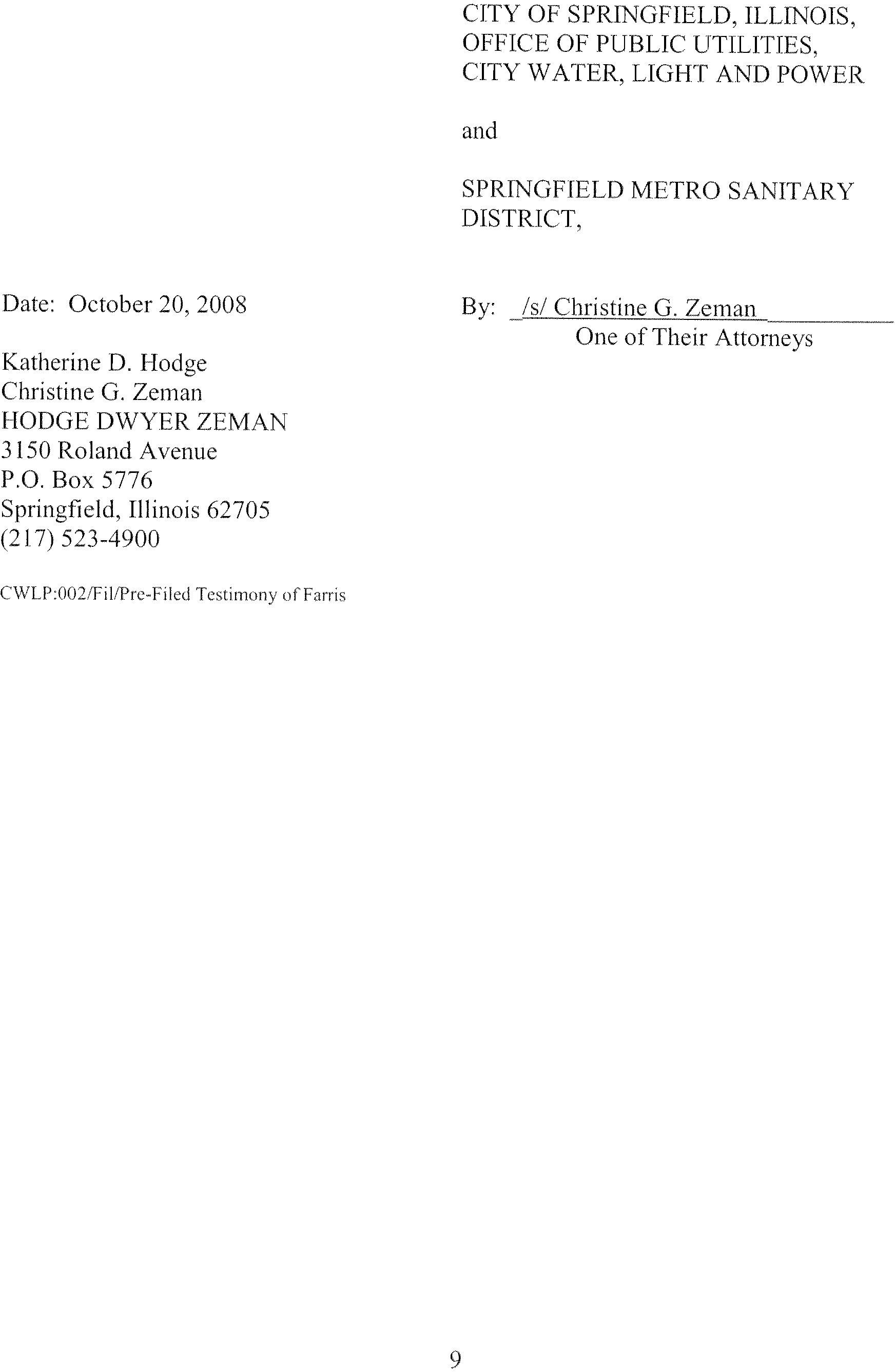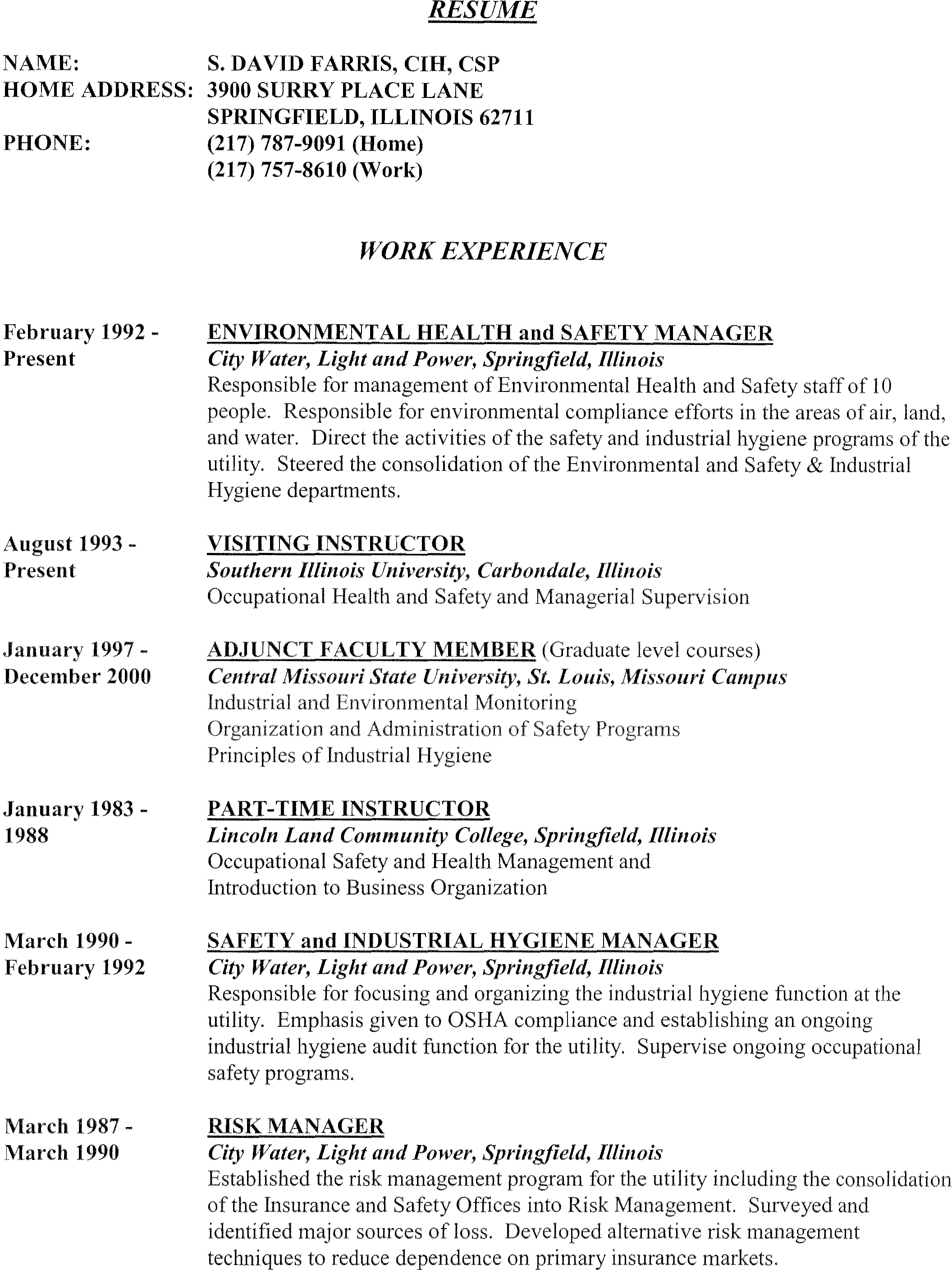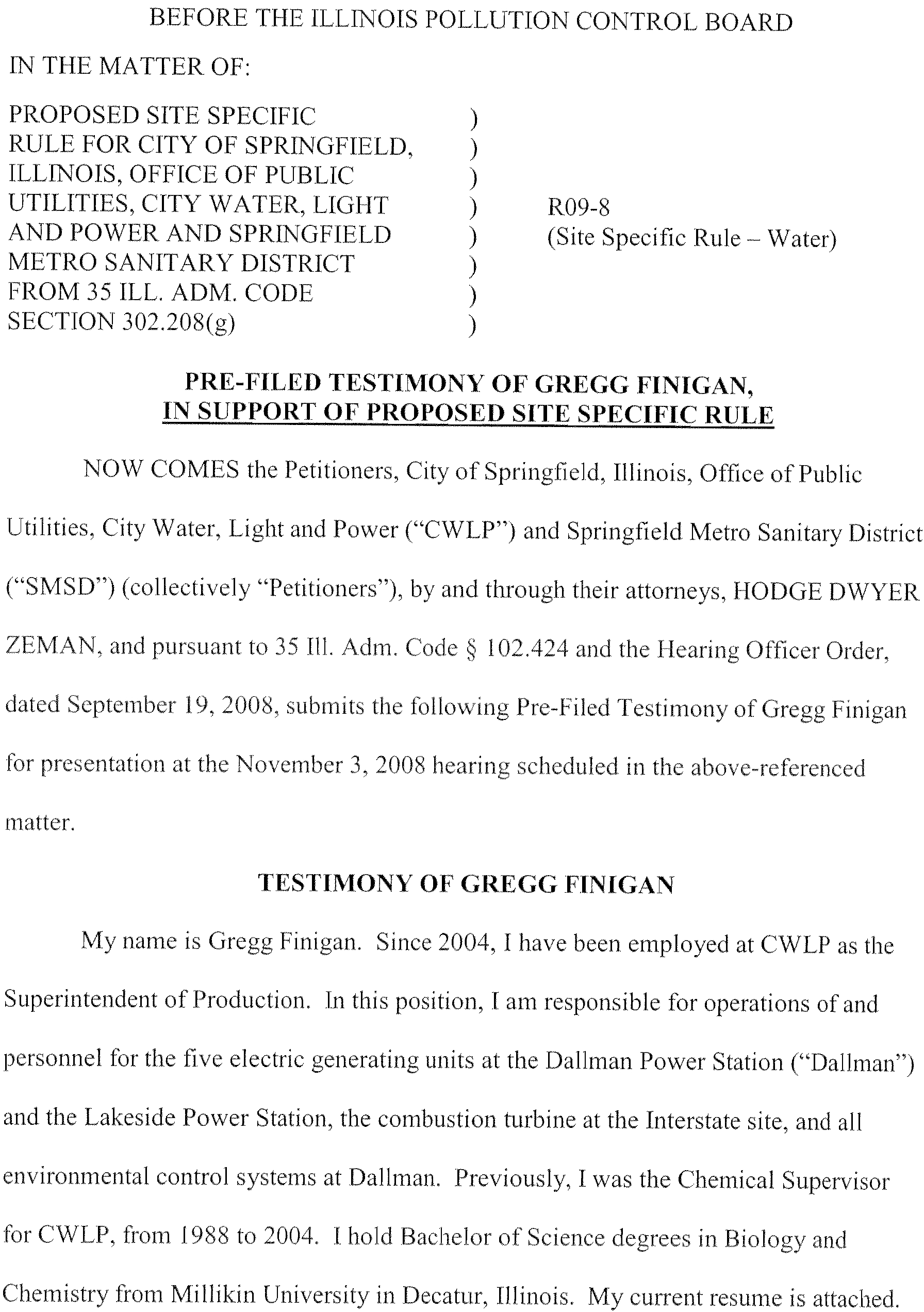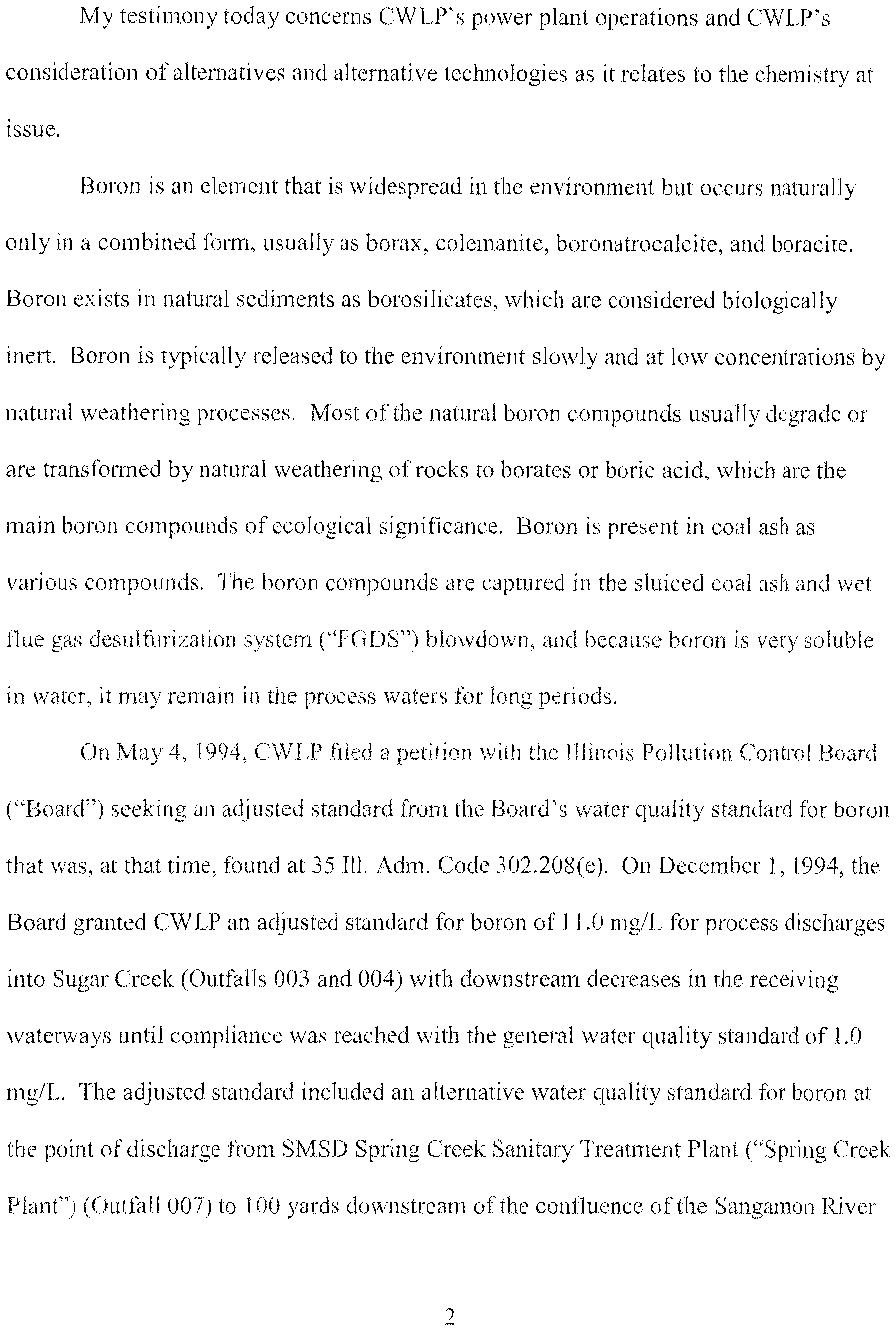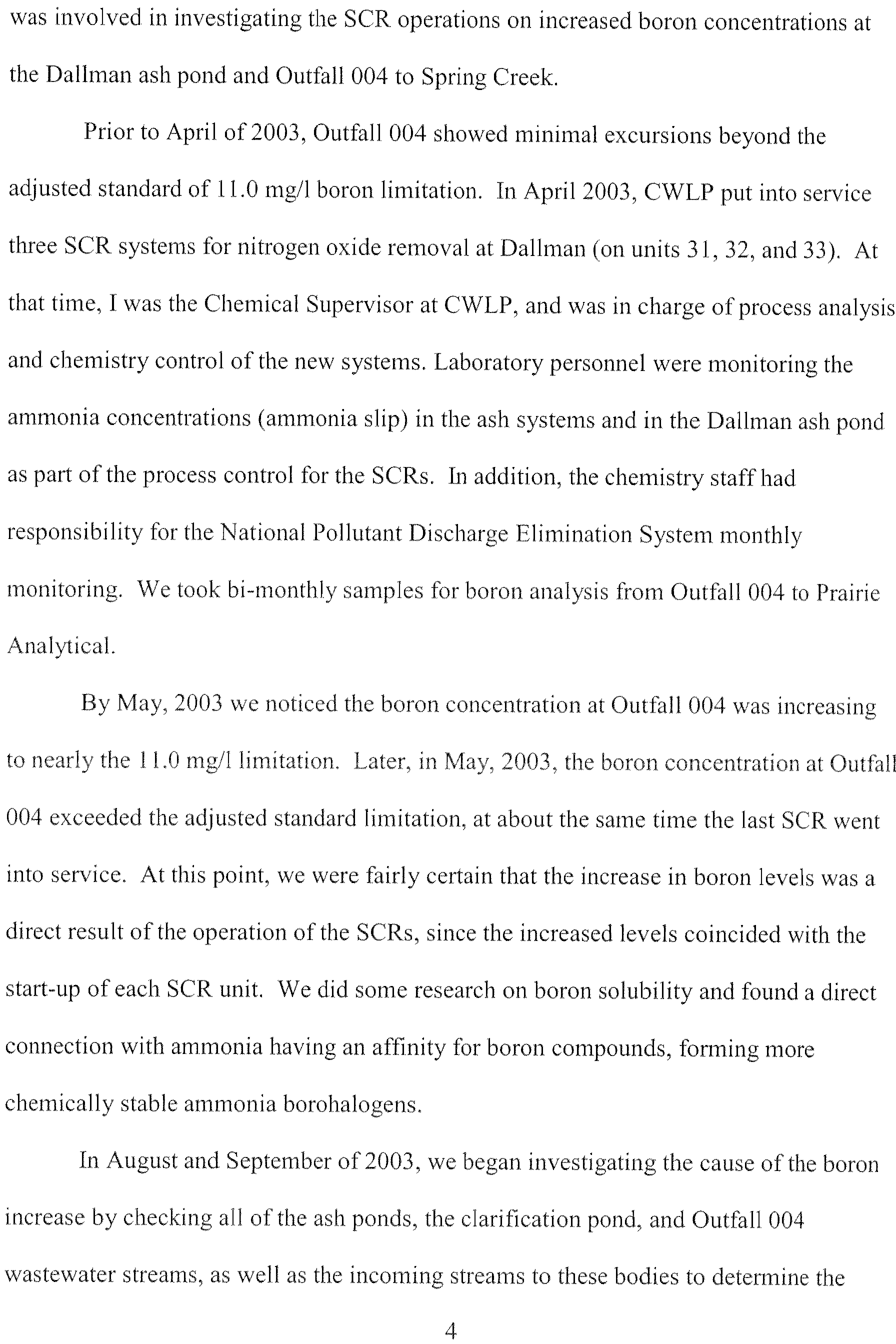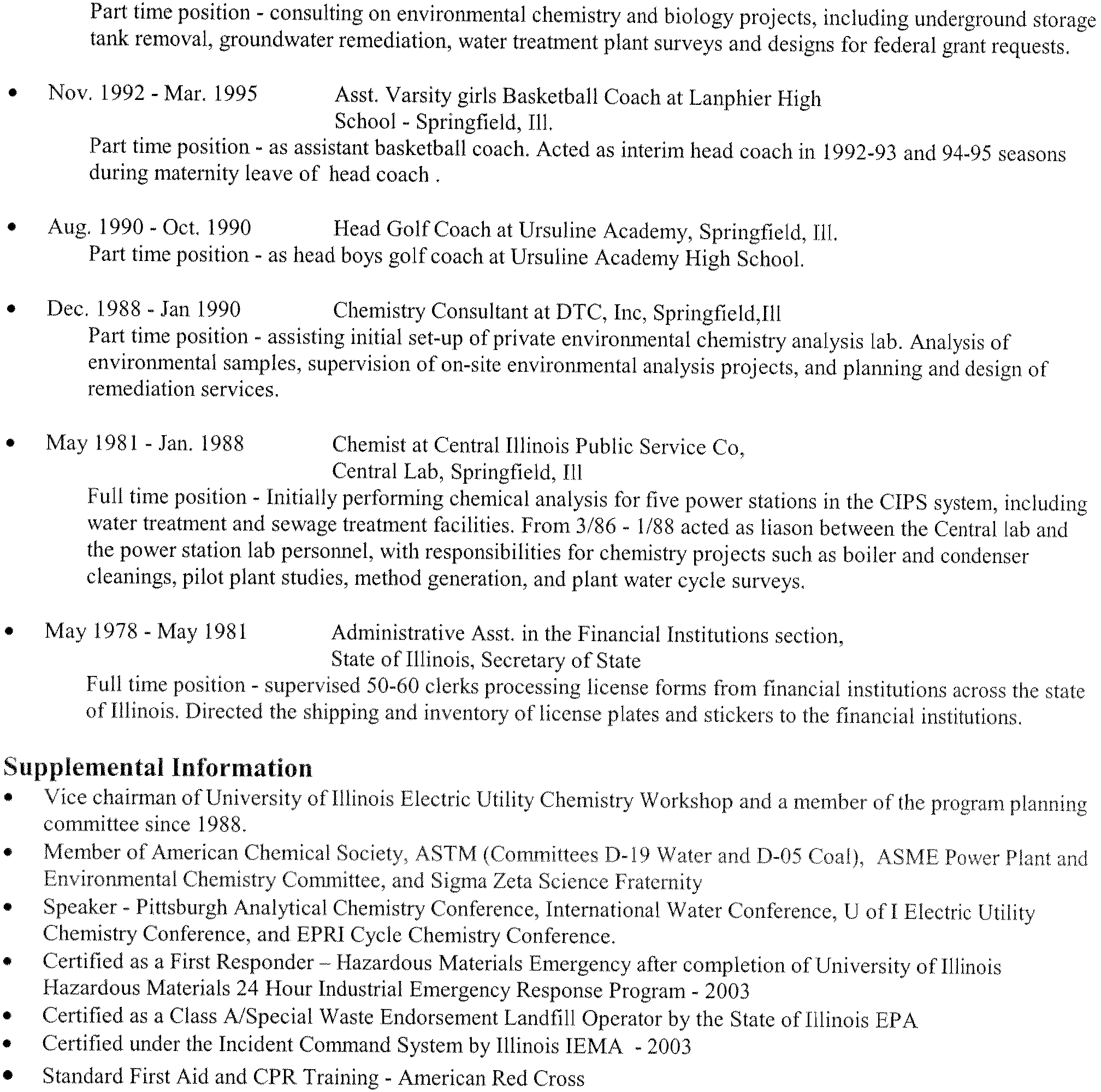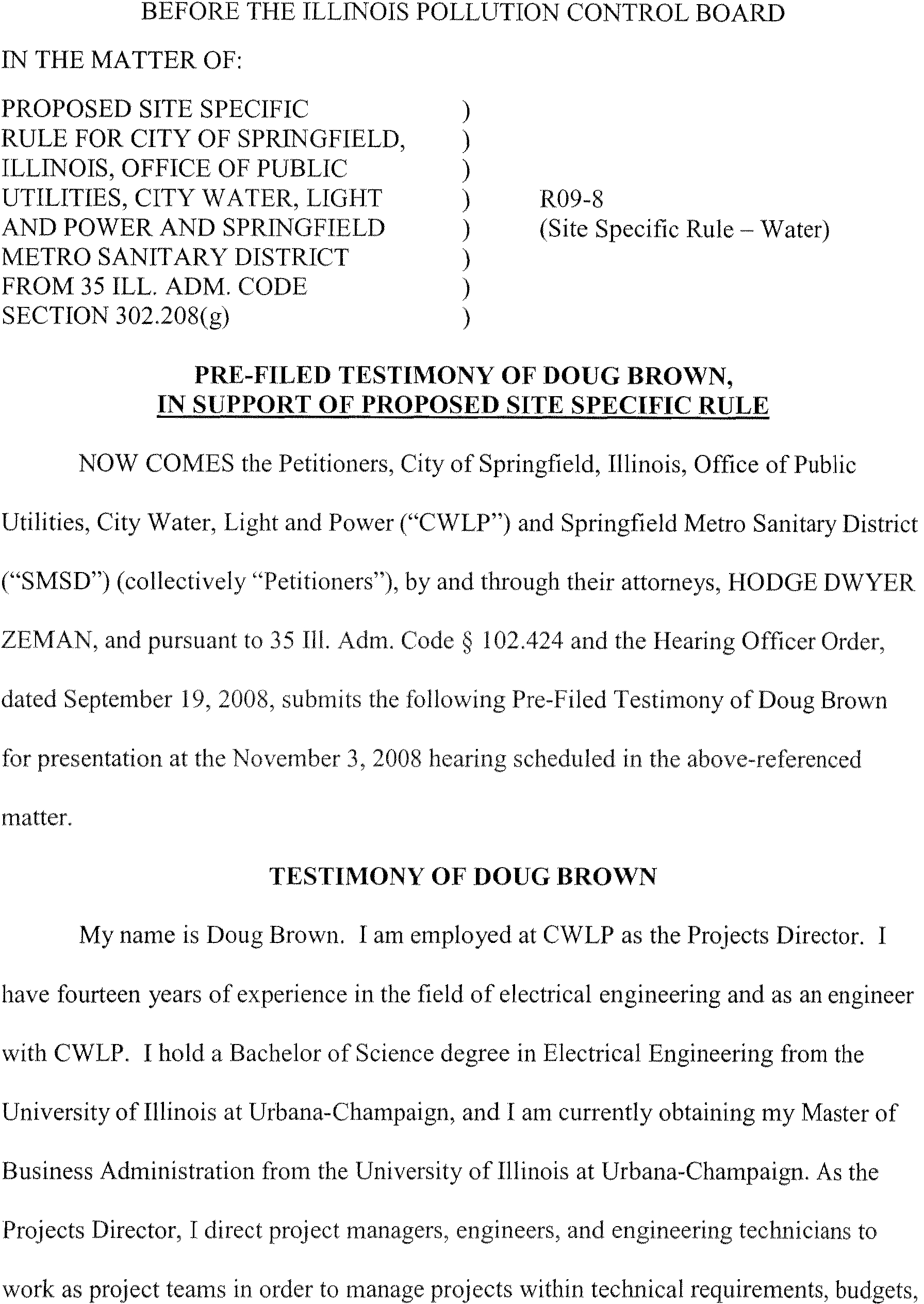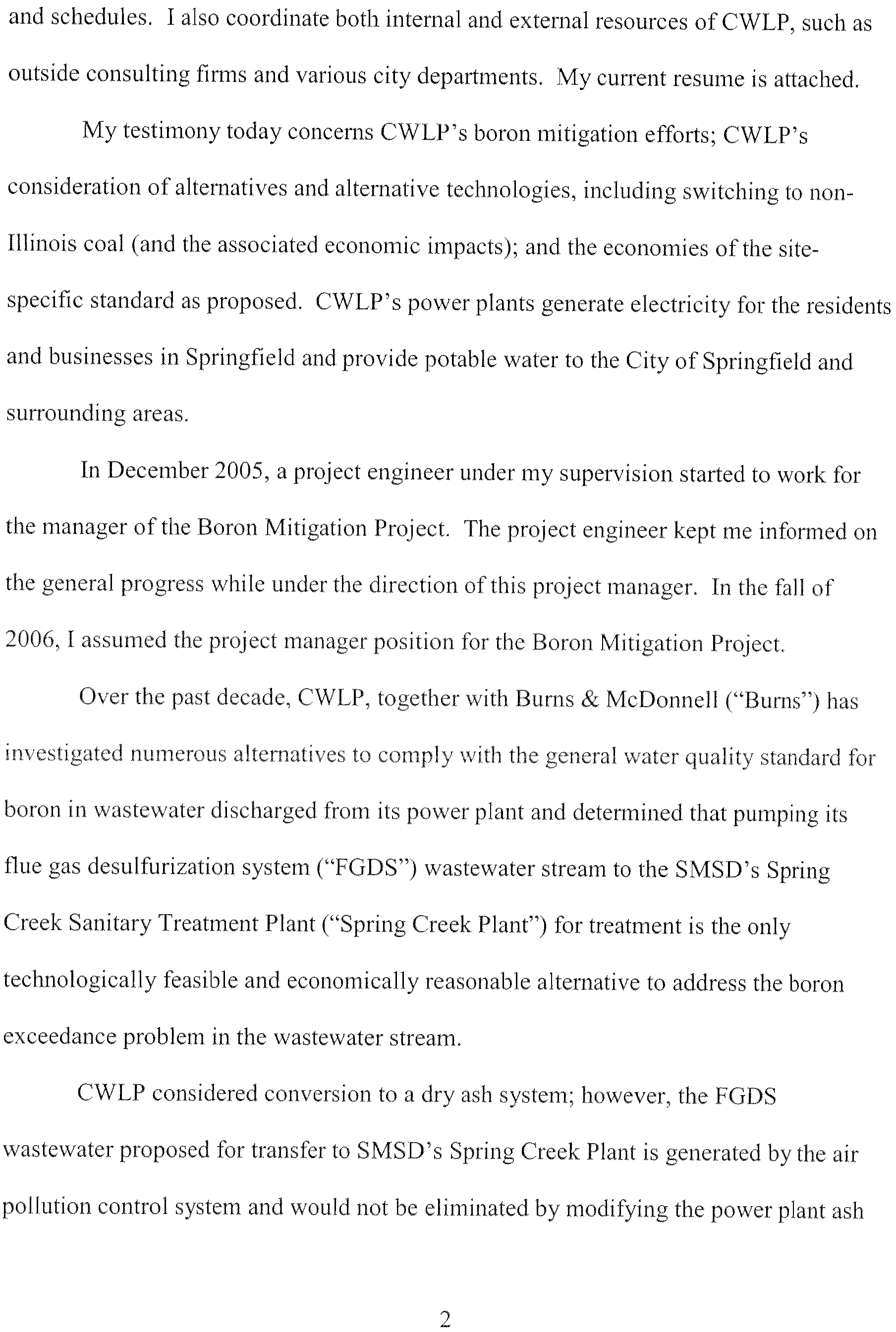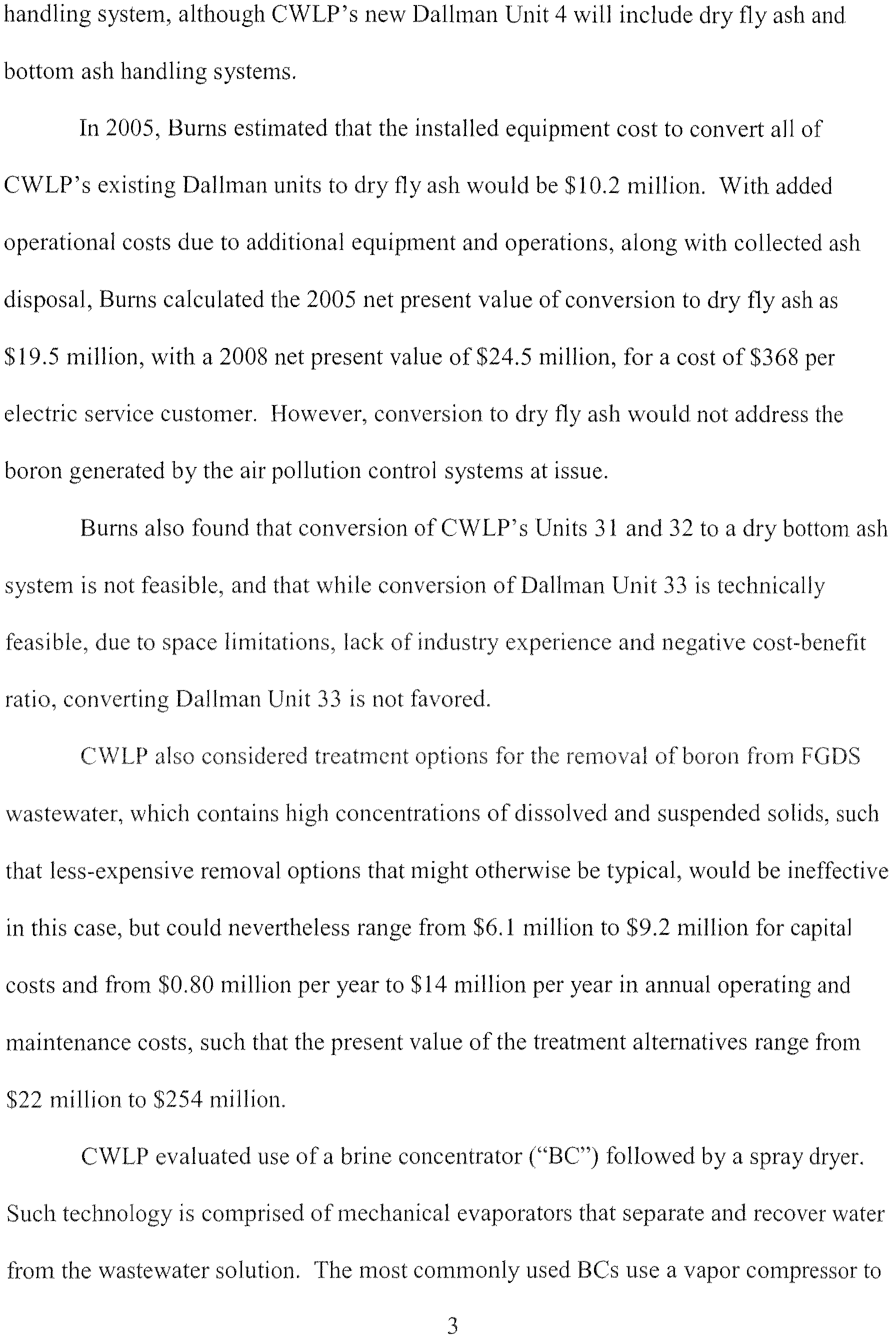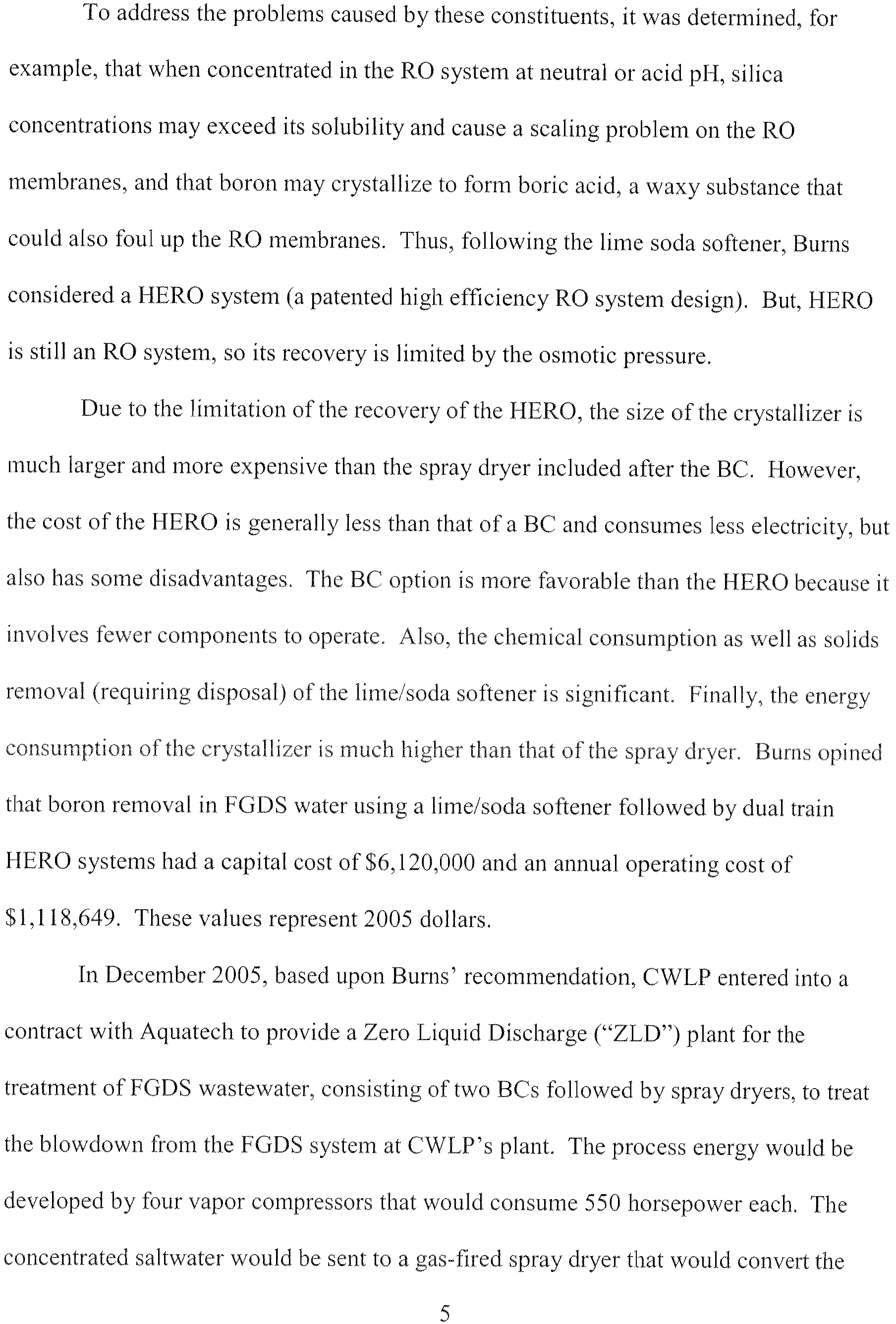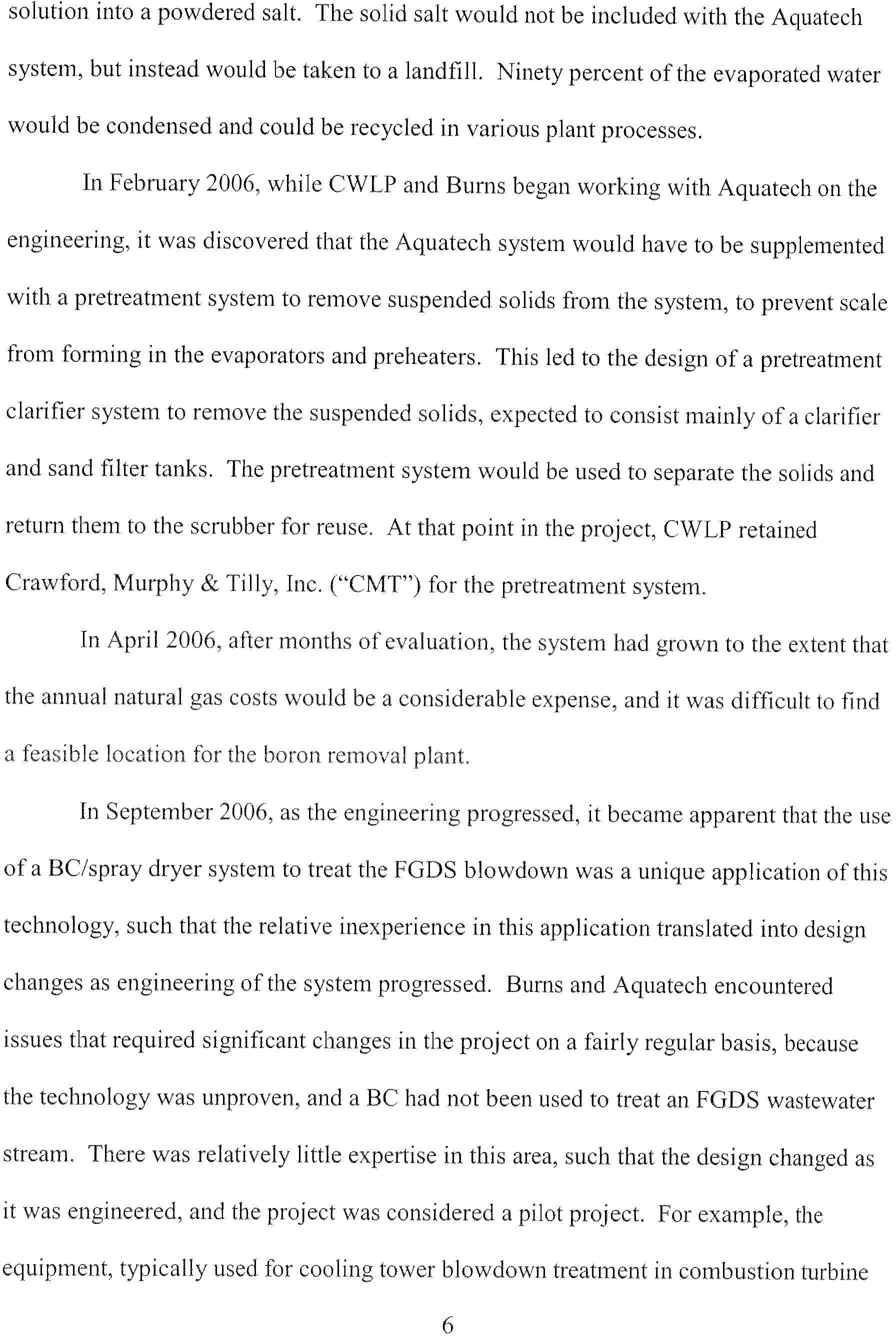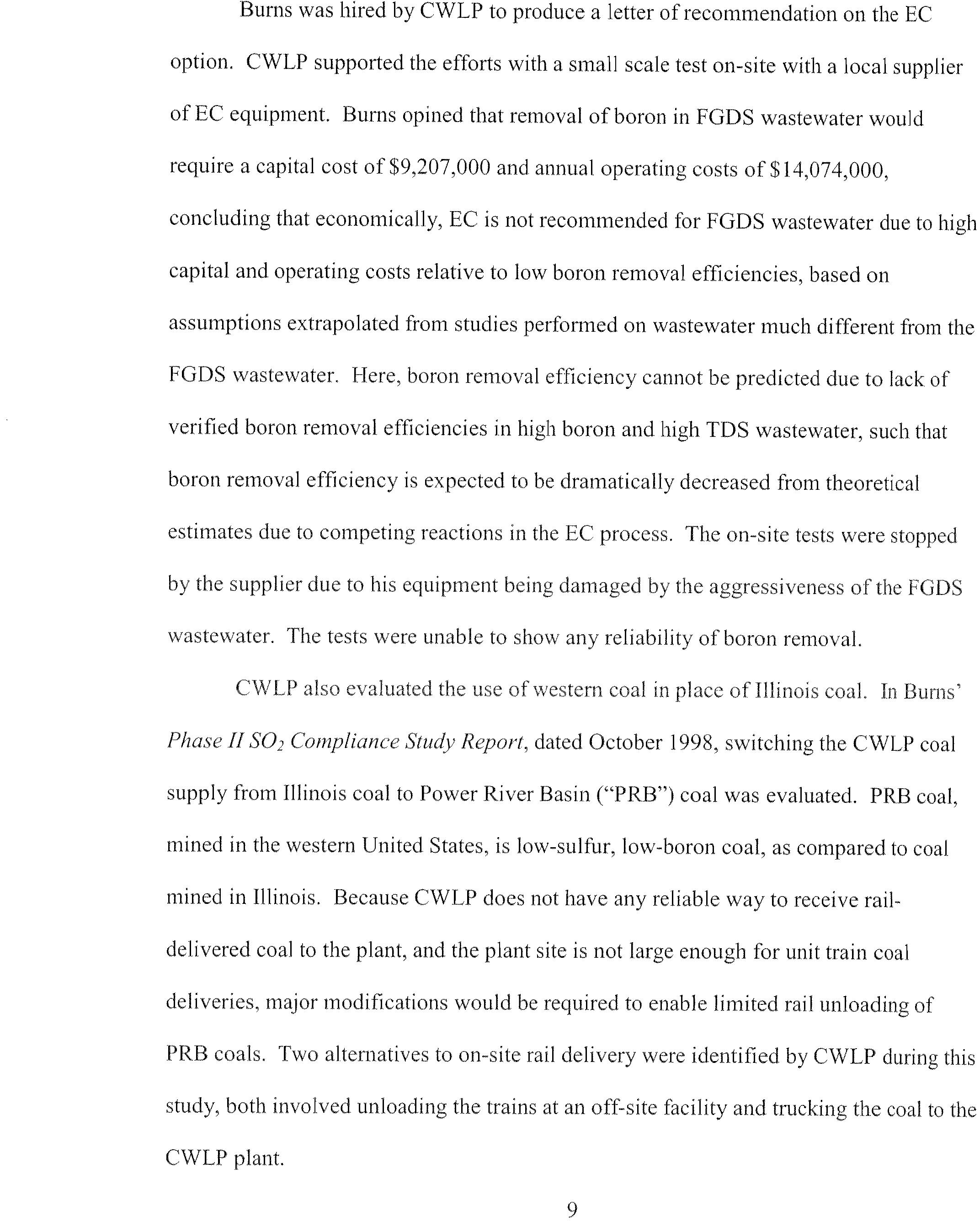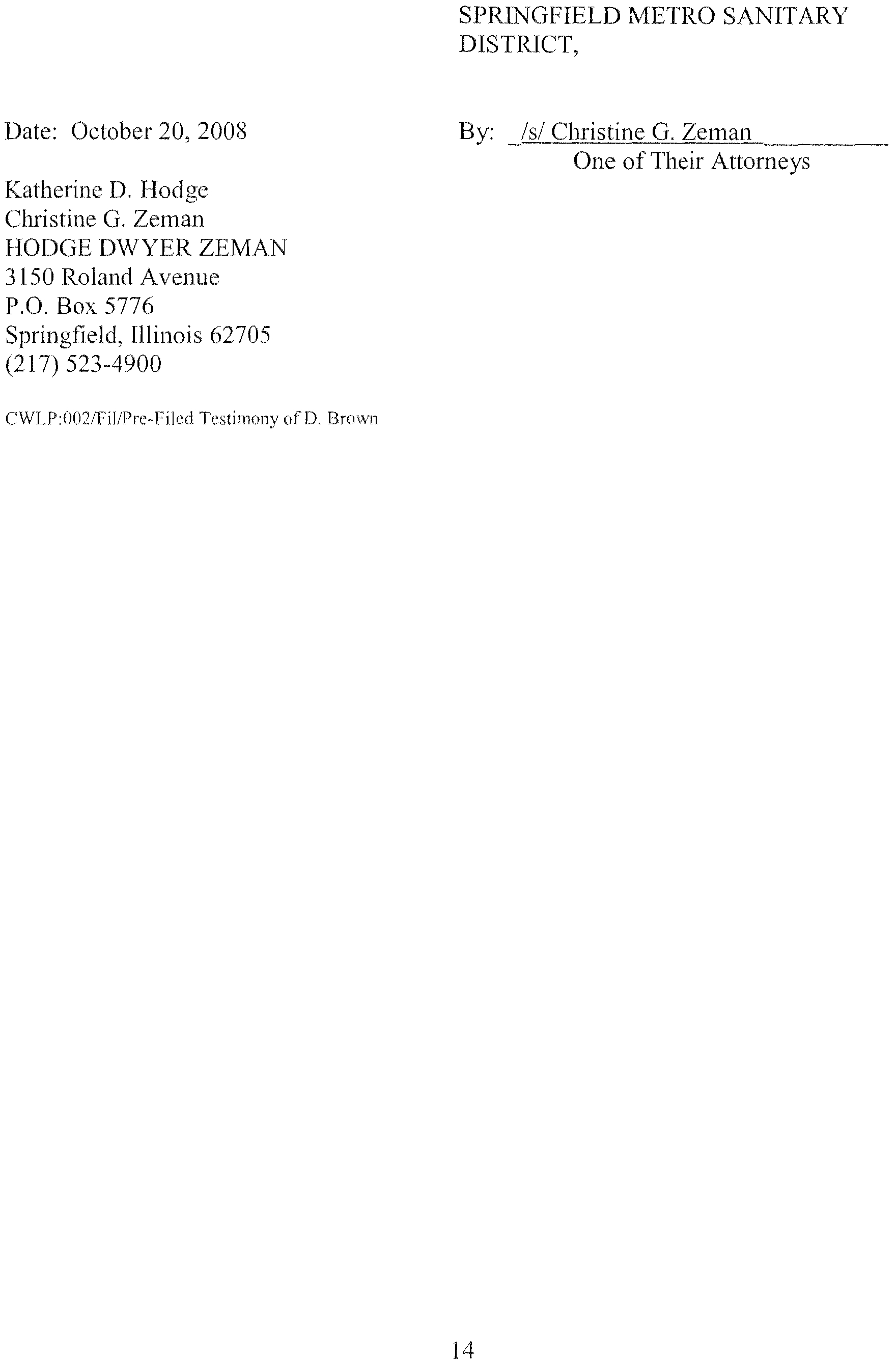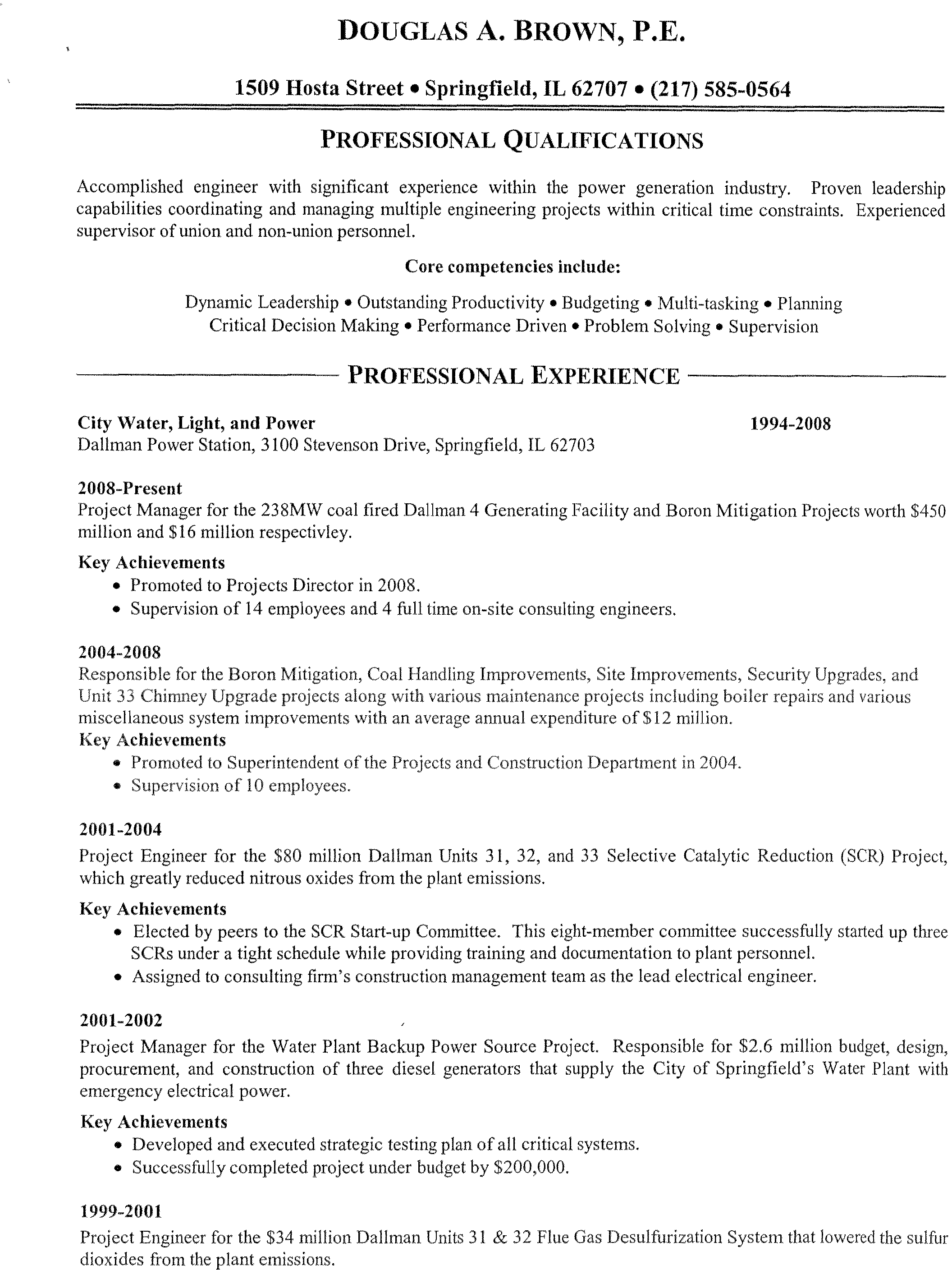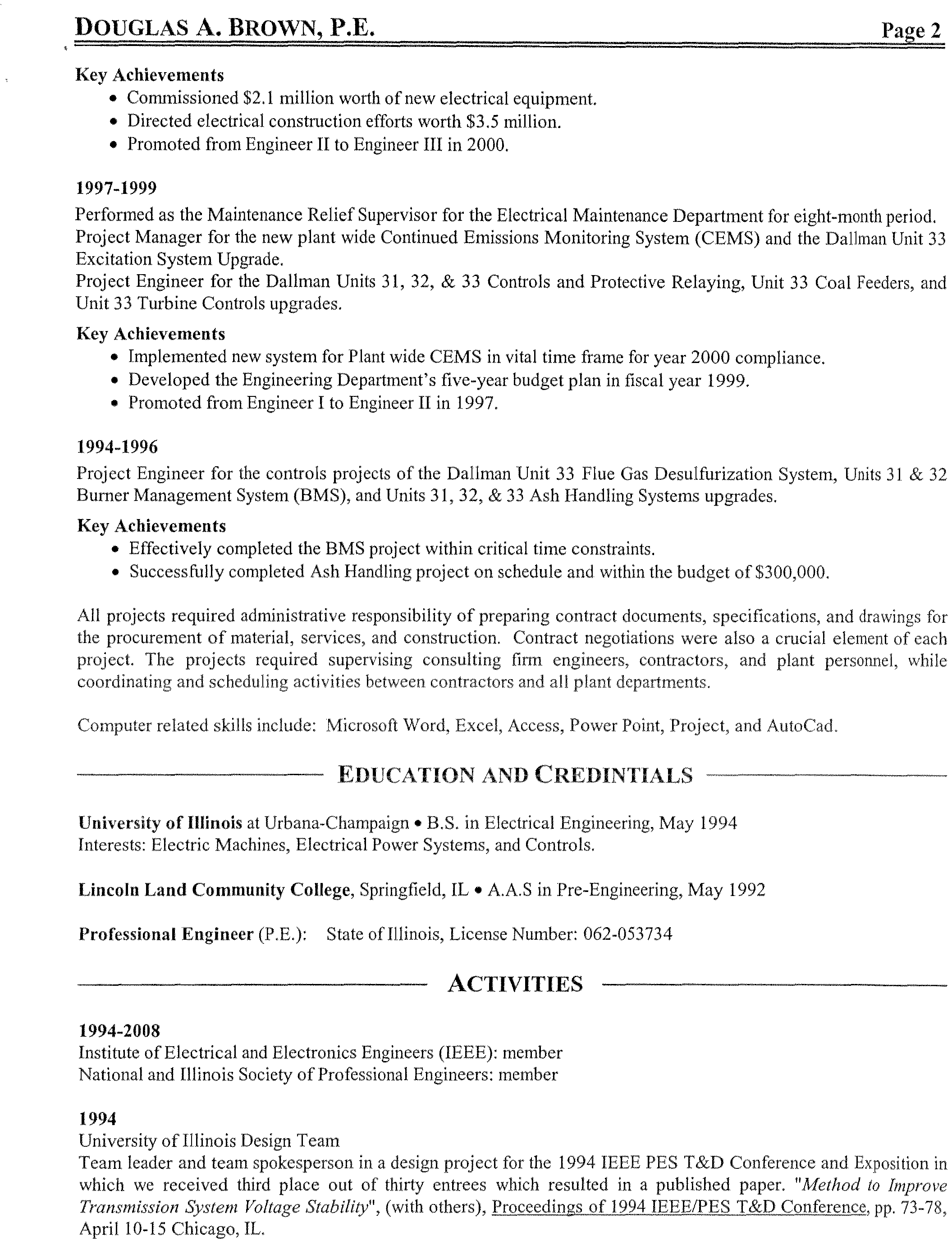'FORE'
POSED S
RULE FO
ILL
TIE
OF:
UTI
SECTION 302.208(g)
NOTICE OF FIL
TO: Mr. John Therriault
Assistant
Clerk of the Board
ago, Illinois 60601
n
trot Board
1
00
West Randolph Street
Suite
11-500
Marie
°i
ecific .Rulernaking - Water)
Pollution Control
Board
James R. Thompson Center
100
West Randolph.
Suite I
Chicago, Illinois 60601
S.
ith the Office
of the Clerk of the
SITI
SN CIFIC
1-'«1>i
)',1
r)
SITE
1 T Cth 1 G 1a PRC)
'I I .--l 1 `40NY
OF GREGG F
RF,-!-ILLD TFSTIMONY OF
FIC
RULE; PRE-FILED TES
LUTION
C
}
R09-S
it
I '1'.I'-FILED TI
1_C,11 f C RULE,
I.'
c;1)I-Vtfully subiruteed,
INGFIELD, ILLINOIS,
OFFICE
OF PU
and
DISTRICT
Date: October 20. 2008
By: lsl Christine G. Zcinuw
One of Their Attor
LED PAPER
Electronic Filing - Received, Clerk's Office, October 20, 2008
BEFOR
THE MATTER
OF:
SPECIFIC
RULE FOR
CITY OF S
ND SP
ILLINOIS, OFFICE
OF PUBLIC
S, CITY WATER,
LIG
Specific Rule - Watei°)
ETRO
SANITAR
Public Uti
ingfield, Illinois
("
Light and Power ("CWLP")
and Springfield Metro
Sani
("SMSD") (collectively
08, su
Pre-
h .
r
,-,
k
: ncnced
matter.
My name is Dave Farr
oners"),
by and through their
attorneys, HODGE
CW
P as the Environmental
Healt
have aver thirty years
of experience in the area of
environni
emphasis ii
. I hold a Bachelor
of Science in
eld), a
nal Safety from Illinois
State University, a Master
of Business
11
Sangamon
State University (which is now
known as the University
Electronic Filing - Received, Clerk's Office, October 20, 2008
My testimony
today concerns
a description of
CWLP's facility,
CWLP's National
Pollutant
Discharge Elimination
System ("NPDES")
permit
and the limits therein; an
overview of
s boron mitigation
efforts; and an overview
of CWLP's
consideration
of
alternatives and alternative
technologies.
CWLP owns
and operates two power
stations, referred
to as the V.Y. Dallman
"Dallman") and
the Lakeside Power
Station ("Lakeside"),
and a potable
water treatment plant
at 3 100 Stevenson Drive,
Springfield,
Sangamon County, Illinois.
These
plants generate electricity for
the residents and bus
ding communities.
Approximately 186
r treatment
plant. T
ed at Dallman and
Dallman has an
8, 1972, and
atin
r c,,l3cetively.
Units 3.1. and 32 are identica
rived
megawatts of generating capacity.
1,250 psig an
boilers
in Units 31 and 32
operate at
nit 33 includes a
tangentially fired boiler and
has a generatin
it 33 operates at 2,400
psig and 1,000°F. Each of
the
man units
is equipped with a flue gas
desulfurization system ("FGDS")
that
,er 90 percent of the
sulfur dioxide from the unit's flue
gases. Selective
Catalytic Reduction ("S
R") air- polluti
removal
were added to all three Dallman Units
in 2003. CWLP currently
operates the
wring the ozone season (May
1 through September
30) to remove approximately
Electronic Filing - Received, Clerk's Office, October 20, 2008
90 percent of ISO,; from its air emissions at the Dallman units. The
SCRs
will begin year-
round operations in July 2009, to assist in control
of the mercury em
began
opera
turbine generators
Originally, there were ei
Only two boilers and two
turbine generators are still in
7 and 8 are
identical
33-megawatt cyclone coal-fired units. Boiler 7-
Turbine 6 went into operation in 1959, and Boiler 8-Turbine 7 began operation
4.
900°F. Lakeside
will be retired in the near future.
Total coal consumption at the CW
l
s atCW P are typical for a coal-fir
Bottom ash
ds. The raw lake water used for
ed frnm the once-through c
c,_ýiiJ,-i l 's.
Tin,, ý:
__ (.i),1+,1i1,.
Dal loran Unit 33, and -
illion tons per year.
ýzý n-- serve Dallnan Units 31 and 32,
,,I Id
bottom,
1
lant sludge and
leachate
collected
ash
scrubber
sludge landfill
adjacent
to the ash ponds.
The south
dividin
1
normally
discharged to
The east portion of the pond, re
s treams
v ary, but
depend
receives lime sludge from the filter plant and miscellaneous
water
an, including the F GDS e
ally upon the generating units in service.
3
Electronic Filing - Received, Clerk's Office, October 20, 2008
A new electric
generating un
about 2,440
rred to as Dallrnan
Unit 4, is currently
un
The Dallman Unit 4
will include a coal-fired
boiler wi rated capacity
250 megawatts.
The new boiler will be
equipped with low-NO,
combustion technol
owing air pollution
control systems: SCR, a fabric
filter, wet flue gas
tan
itator.
Dallman Unit 4 will utilize
a dry ash
able water treatment plant. has a
capacity o
day. A
conventional lime-softening/filtration/disinfection
process is
employed to
produce potable water. Five clarifers
and
late
matter from
Spaulding
em.
1
,.v.
; i
/hour
and a steam turbine-generator
with a nominal
capacity of
v+ titer from
the filters is disciýaý-,._ý ý_I to ash ponds
located north of
c _[ backwash
water discharged to the ash pond
and herbicides. The PAC
also
he clarifers
and disposed
in the ash ponds.
Lake S gfield, a 4,224-acre
rese
ucted in 1934
by
impoundment
o
oling water for the CWLP complex,
for the City of Springfield
and
ms flowing into
Lake Springfield are
and ick Creek, which drain i
Electronic Filing - Received, Clerk's Office, October 20, 2008
se of lake
water for the C
for 3.9 million gallons
of lake water usage
ive a variety of n
Dallman and Lakeside
and the
which
also provi
under a
ter, flows into a clarification
pond,
on, before it discharges
into Sugar Creek
renewal t
on discharges from
is Pollut
Board's water qu
Lied by the Illinois Environmental
Protection Agency
rnatant from
the two ash ponds,
lading miscellaneous
water streams from
ES permit
issued in 1991, IEPA placed
a boron
the clarification pond. On May 4, 1994,
CWLP filed a petition
Control Board ("Board")
seeking an adjusted
standard from
on that was, at that time, found
at 35 111. Adm,
Code 302.208(e).
On
December
1,
m gll
reek (Outfalls
00
compliance was reached
the Board grant
`..tC \i it Cr d
T he aajr!
!:.
uality standard for
boron at the point of discharge frog
downstream of t
alternative water qu
tandard for boron al
ns of
waters
at issue in this matter.
From 1994, when the
adjusted standard was granted, until May 20
neral compliance of its NPDES Permit IL0024767,
However,
("Spr
ant") (Outfall
007) to
on River
with Spring Creek. Thus,
an
inting
11.0
Electronic Filing - Received, Clerk's Office, October 20, 2008
mg/
at Gutfall 004, co iding
wi
systems.
Subsequent
to a meeting with IEPA
in July 2003, CWLP
committed to a further
of the process
chemistry and interaction
o
s treams;
It Il1ve
w astewater streams with high
boron content. CWLP used both internal
resources and
those of
investigation
demonstrated that the FGDS
blowdown, or the scrubber
return wa
tering
the scrubber solids (gypsum),
was a primary culprit ii
nson Professional
Services Inc. (" Hanson")
to conduct this investigation.
The
h boron levels in the
h the testing and start
of SCR air pollution control
reams of C7utfall 004,
to identify the
d.
Levels above 500 mg/L were identified
i
afc"riril
i`;
rcncrated by
dewatering the scrubber
-+rc,,Amately
200,000 gal
IEPA concerning the
On November 25, 2003,
response,
1 and its
progress in identifying
LP received a violation notice
("VN") from IEPA
00471). CWLP responded to the VN
ry 12, 2004. In its wri
LP exp
wastewater streams of CJutfall 004 wi
retained Hanson to investigate the
causes of the
s m o
o
n
to characterize the
ration, and after they had
beer
shut down following the
ozone season. On February 11, 2004, IEPA
accepted CWL
2004, w
Electronic Filing - Received, Clerk's Office, October 20, 2008
e
date of May 2005 was proposed. In the interim, for the remainder of
ampl
confirmed that a highly significant contributor of boron to Outfall
004 was
the PGDS
blowdown wastewater stream, or scrubber return water from
the gypsum de-watering
system.
On
July 28, 2004,
CWLP proposed to IEPA a three-prong approach to solving
the boron exceedance issue, including a proposal to engineer and design a temporary
for the
2004 ozone season,
nd would be included in the construction of the new Dallman Unit 4. A
hich discharge into the ash ponds and
for
ream was unfruitful
()
s
Oh, CWLP met with IEPA to
ion project. CWLP requested to amend the project implementation
schedule as the application o
r ns>,
s
ibility
of
permanent wastewater treatment options. The
outcome of
IE
ile a permanent
facility was
rovided recommendations to CWLP to pursue a brine concentrator and spray
rber. I
ional inve
continuously operate the Lakeside sluice
r earnaj
i>r,ý<<_j,
o logy was very unique and the consulting
ndor encountered
issues
that
required
significant changes in the project on
as now determined to generate order of magnitudes
e cost had expanded many times the
original
$13 million price
7
Electronic Filing - Received, Clerk's Office, October 20, 2008
ed six months, or
until April 9, 2007,
to fully evaluate
all alternatives.
The
feasibility and cost assumptions
for the
brine concentrator are
no longer valid.
2007,
C
m et with
IEPA and proposed
to construct a pretreatment
system
for the FGDS blowdown
consisting
of a ClariConeTM/clarifies- and
the addition of
force ma
WLP requested
a 90-day period,
or until July 9, 2007,
to pursue
stream
would be sent via
this strategy and submit
to the Agency design
and schedule information.
CWLP would
also
have to consider the need to work
with S
In May 2007, at
the request of the Agency,
electrocoa
r unt im
a nd
a bench top test was conducted
utilizing this waste
stream. The data generated from
coagulation would
be prone to failure
tewater
stream to the MSD
Srrrin;- Cn.vi
ith the SMSD Spring
Creek Plant for boron.
revised
CCA and granted an
extension to attain compliance with
the 2
chic
notice by August 2009.
Documents relevant to my testimony
related to the
VIN1 and
n the record
of this proceeding as Group Exhibit
A attached to
/new.
Respectfully su
8
Electronic Filing - Received, Clerk's Office, October 20, 2008
ILLI
OFFICE OF PUBLIC
UTILITI
CITY WATER,
and
Date: October 20, 200
I-Iodge
Christine G. Zen
IIODGE DW
P.O. Box 5776
field, Illinois
62705
-4900
Electronic Filing - Received, Clerk's Office, October 20, 2008
RESUME
a SURRY PLAC
GFIELD, ILLINOIS 6271-1
787-9091 (Home)
7) 757-8610 (Work)
'RIENCE
2 -
AFETY
City Water, Light and Power, Springfield, Illinois
Responsible for management
of Environmental Health and Safety staff of 10
for environmental compliance efforts in the areas of air, land,
3-
Southern Illinois University,
Carbondale,
Illinois
id Safety and Managerial
Supervision
Jamiar
D ccc-aber
I ND
nd industrial. hygiene programs of
the
Missouri Campus
h -Aion
of
S al,
1y
P rograms
I icne
J anuary 1983 -
February 1992
Light
and Power, Springfield,
Illinois
anti organizing tfhe industrial 11ygie ne
afety & Industrial
safety programs.
City Water, Light and Power, Springfield, Illinois
isk management prograrn
of the Insurance and Safety 0
e ongoing occupational
ources of loss. Devel
es to reduce dependence on
Electronic Filing - Received, Clerk's Office, October 20, 2008
January
1980 -
March
1987
City Water, Light and Power,
Sprin eld, Illinois
Completely
restructured the existing
safety program.
Responsibilities included
all
aspects
of employee safety, accident
prevention,
fire safety, industrial
hygiene, and
workers' compensation.
Responsible for direct supervision
of professional
employees in the Safety
Office.
1978
-
ry 1980
TOR
Western Illinois
University, Macomb,
Illinois
ongoing
safety program
which included fire
safety and employee
health and safety.
LOSS
CONTROL REPRESENTATIVE
Crum and Forster Insurance,
St. Louis, Missouri
Responsible
for inspection and
evaluation of risks from
a fire safety, workers'
d liability
standpoint.
r 1985
Rnsiuess
Administration (M
S1.1tý-
_
;ti:t_fc, t
y
I llinois
State
PROFESSIONAL
AFFILIATIONS, CERTIFICATIONS
AND LICENSES
C ertified
Safety Professional
Safety Professionals
Certified
in Comprehensive Prac
Agency
American
Elygiene Associa
Licensed
Industrial Hygienist
Exami
t. Louis
Local Section
American Industrial
Hygiene Association: Fundamentals
of
Industrial
Electronic Filing - Received, Clerk's Office, October 20, 2008
E ILLINOIS POLLUTION
CONTR
?IC
FOR
CITY OF SPRINGFIELD,
OIS, OFFICE
OF
PUBLIC
ITIES, CITY WATER,
METRO
SA
R 0 9 - 8
u le -- Water)
FROM 35 ILL.
E-FILED TESTIMON
Illinois, Office
of Public
t and Power
("CWLP") anti Springfield
Metro Sanitarv Di
("SMSD") (collectively "Petitioners"),
by and through
their attorneys, HODG
.424 and the hearing
ed in the aboti rui. rýý
igan.
Since 2004, I have been employed
at CWLP as 11-
S uperintendent of Production. In
this position, I am responsible
for operations of and
personnel for
the five electric generating units
at the Dallman Power Station
and the Lakeside Power- Station,
the combustion turbine at the Interstate
site, and all
environmental
control systems at Dallman. Previously,
I was the Chemical
P, from 1988 to 2004. I holed Bachelor
of Science degrees in
Bi
Oho 302208(g)
)
University in Decatur, Illinois. My
current resume
Electronic Filing - Received, Clerk's Office, October 20, 2008
ony today concerns CWLP's power plant
operations and CWLP's
alternative technologies
as it relates to the chemistry at
Boron is an element that is widespread in
the
environment taut
occurs
sually
as
borax, colemanite, boronatroca
Boron
rural se
s borosilicates, which are
considered biologically
ically released to
the environment slowly an
ering processes. Most of the natural. boron
compounds usually degrade or
are transformed by natural weathering of rocks
to borates or boric acid, which are the
-on compounds of ecological significance. Boron is present in coal ash as
various compounds. The boron compounds are captured in the sl
iDS") blowdown, and because boron i
ocess ),,
1'ý "-?
1
ds.
t ro'
T..?
?
;r
for boron
that was, at that time, found at 35 111. Adm. Code 302.205(e). On December 1,
003 and 004) with downstream decreases in the receiving
n adjusted standard for boron of 11.0 mg/L, for process discharges
waterways until compliance was reached with the general water quality
standard of 1.0
adjusted standard included an alternative water quality standard for boron at
of
C}utfall
Spring Cr,
ý,1ý
Sanitary
Treatment
Plant (
confluence of the
Electronic Filing - Received, Clerk's Office, October 20, 2008
to portions o
s matter.
able
to operate while meeting
the adjusted boron
standard in Sugar
Creek. However, since Selective
Catalytic Reduction
("SCR") air
pollution control
systems for removal
of nitrogen oxides were
added to Dallman's three
an alternative water quality standard
for boron already
app
coal-fired uni
for boron
through
Se
ification pond. The
increased boron levels
from the Dallman
ash
pond are below the adjusted
standard, but when the boron
content o
FGDS
lan d i 4 ; i c i ()n
the boron concentration at
Outfall 004
are als-
F,,
be quanti
,.
o,
,
Conversion to a dry fly ash system will
n.y other
owdown stream,
h boron
ons
anon in the
since it is generated
by the air pollution control equipment
(FGDS treats the flue
gas
roduct
of burning coal) and is not associated
with the fly ash disposal
system.
As Superintendent
of Production and Chemical
Supervisor, l have been
its to investigate
the effect of operation
of the
0. Apparently,
trace ammonia concentrations
from SCR oper
Creek. The SCRs operate
during the ozone season,
from May l
2003,
CWLP has had difficulty
complying with the adjusted
standard
reased
boron solubility
boron concentratio
Electronic Filing - Received, Clerk's Office, October 20, 2008
was involved
i
the Dall
ash pond and
Ctutfall 004 to Spring Creek.
d boron
concentrations at
Prior to April
of
2003,
Outfall 004 showed minimal
excursions beyond the
adjusted
standard of 11.0 mgll boron limitation.
In April 2003,
CWLP
that
time,
systems for nitrogen
oxide removal at Dallman (on
units 31, 32, and 33). At
he Chemical Supervisor
at CWLP, and was in charge of process
analysis
and chemistry control of the new
systems. Laboratory personnel
were monitoring the
in the ash systems
and in the Dallman ash pond
as part of the process control for the
SCRs. In addition, the chemistry
staff had
responsibility for tl
charge Elimination
System monthly
nthly
samples for boron. analysis
Analytiý . .,1.
itation.
last SCR went
boron levels was
a
startup of eac
chemically stable arnmoi
chec
limitation, at about
ided wi
e did some research
on boron solubility and found
a direct
ammonia having
an affinity for boron. compounds, forming
more
d September of 2003,
we began investigating the cause
of the boron
wastewater streams, as well as the incoming streams
to these bodies to determine
the
4
Electronic Filing - Received, Clerk's Office, October 20, 2008
of the increased
boron concentration.
This study was
done in conjunction
with
Engineering, which
is now known as Hanson
Professional
Services I
this extensive study
of all of the wastewater
streams
not to the levels that would
have exceeded the
we were
able to ident
into Outfall 004 to
Sugar
allman ash pond had increased,
but
fisted standard
of 11..0 mg/l. However,
FGDS blowdown effluent
stream contained excessive
amounts of boron, from
16.4 to 837 mg/l. This
effluent was found
to be 250,000
0 gallons per day being sent to the
filter plant sludge ponds,
which subsequently
discharge supernatant to
the Clarification pond, which
flows to Outfall 004,
present
prior to the operation
of the SCR
sed boron concentrati
4, resultil
ich is the major
of the
SCRs and the ammonia
effect on boron solubility, increased
the boron level to the
wdoa,Ni n =, rý,:;; ii
l boron
f,_
( ,. ould not:
'be
oposal will not eliminate
CWLP's need for the adjusted
standard; it is the
most
reasonable approach
for CW Ptome
I will be happy to answer any que!
Respectfully
submitted,
CITY O
OFFICE
OF P
and
Electronic Filing - Received, Clerk's Office, October 20, 2008
Date:
October 20, 2008
By:
Katherine D. Hodge
Christine
TRO SANITARY
istine
G. Zeman
_
One of Their
Attorneys
3150 Roland Avenue
1'.O. Box 5776
llinois 62705
(217) 523-4900
C'WLP:002/Fil/Pre-Filed
Testimony of Finigan
Electronic Filing - Received, Clerk's Office, October 20, 2008
Gregory (Gregg) James Finigan
elaware
Dr.
e d, wife -
Mary
hone: home - (217)
544-111.9
office - (217)
757-8670
Ext. 248
cell - (217) 415-7280
Personal
hree Children - Jennifer, P.J.,
Education
" Graduate - Springfield Lanp
oc
Graduate - Springfield College in Illinois - 1976
Graduate -
I llinois 62702
i ology/Chemistry/Pre-Med)
- 1978
Degrees - Bachelor o
Graduated Magna Cum
1
sc
team Academic All -Amertc
Graduate -
i,-m curriculum.
1 duý-;ition Credits earned from
r C
I
v:. rnistrv Conferences. FGTR
Employment History - Gregory Finigan
" April 2004 to present
Superintendent of Production at City Water Light an.
Iman and Lakeside Po
nits at Dallman and Lakeside, the combos
llman power
ies for the Dallman FGDS syst
improve deminera
ted with project management in the
construction,
start-up, and initiation of a new FGDS at Dallman. Assisted with start-up and operation of three new
SCR.'s at.
Dallman and directed the catalyst management project for the new SCR's.
Dallman Power
H igh Schoo
B ology; Bachelor of Science in Chemistry
i i t_e,_<<<1. Business
,k
1?
11
d ay Operation of the five electric
bine at the Interstate site, and all environment
Chemical Sup
at City Water Light and Power
Springfield, 111.
r Stations
tion - supervising and coordina
chemical staff and lab facili
. Directed projects to
install
on-line
to present
Head Basketball Coach at Lincoln Magnet School (Jr. .High) Spr
ime position - Head
basketball
coach for
8
5
Consultant - Chernistry/Biology at NLTCO, Inc.
Springfield, Ill.
Electronic Filing - Received, Clerk's Office, October 20, 2008
Part time position - consulting
on environmental
chernis
tank removal, groundwater remediation,
water treatmen
" Nov.
1992 - Mar. I
during maternity leave of head
coach .
tion - as
assistant basketball coach.
Acted as interim head coach
in 1992-93 and 94-95
seasons
" Aug.
1990 - Oct. 1990
Head
Golf Coach at Ursuline Academy,
Springfield, III.
Part time
position - as head boys golf
coach at Ursu
" Dec.
1988 - Jan 1990
environmental samples,
superv
o1,
f private
environmental chemistry
analysis lab. Analysis
of
site environmental
analysis projects, and
planning and design of
nd biology projects,
including underground
storage
" May 1981 - Jan. 1988
Chemist at
Central Illinois Public Service
Co,
gfield,
III
Consultant at D"
cleanings,
pilot plant studies, method generation,
and
Full time position -
Initially performing chemical analysis for
five power stations in the
LIPS system, including
water treatment and sewage treatment
facilities. From 3/86 - 1/88 acted
as liason between the
Central lab and
the power station lab personnel, with responsibilities
for chemistry projects
such as boiler and condenser
0
tions sec
processing license forms
from financial institutions across the
state
cc
chairman of U
utitiný:e
°,rný
ri(;;n C
L,, rni, :it
So, 4
'i
ASTM (Con,rr,rr,.-
-.
h-19
Water
and L1-0 G)al),
i
C,Il
r:_ Il
_
.;lid Sigma Zet.ý
i;ýý I ,.ýi
veys and designs
for federal grant requests.
t. Varsity girls Basketball
Coach at Lanphier High
ool
-
Springfield, 111,
o f licem t
p, ;t,.
.And stickers
to the ftnanei
lin,,i! Il_ýtricUtility
Chrnri>,Irý
" Spy ýký._r -PitL,hu
,'h
Aý1,11ý
ticýi.l
Clr.-niiýaty
Conferen;_
Water COnf ýýiý<<ý,:,
U of I Electric Utility
Chemistry
Confcrc
nt
e, and EPRI Cycle Chemistry Cool, i t ii;-c
" Certified as a First Responder -- Hazardous Materials Emergency
after completion of Universit
Hazardous Materials 24
Hour Industrial Emergency Response Program -
2003
" Certified as
a Class A/Special Waste Endorsement Landfill
Operator by the State
" Certified cinder the Incident Command System
by
Illinois
IEMA - 2003
Standard First Aid and CPR. Trait
Electronic Filing - Received, Clerk's Office, October 20, 2008
POLLUTION
CONTROL BO
PROPOSED SITE SPECIFIC
RULE FO
CITY WATER, LIGHT
SPRINGFIELD
)
(Site
Specific Rule - Water)
DISTRICT
l
SECTION 302.208(g)
MONY OF DOUG BROWN,
T OF PROPOSED
SITE S
the Petitioners, City of Springfield, Illinois, Office of Public
ies, City Water, Light and Power (" WLP") and
Springfield Metro Sanitary District
") (collectively "Petitioners"),
by
and through
their attorneys,
I rý .xilig Officer
Order,
almo(ly
o f Doug
a ber 3, 2008 hearing s
m atter.
e cts Director. I
fourteen years of experience
in
the
field
of electrical engineering and as an engineer
or of Sci
at Urbana-Ch
from th
ree in Electrical Engineering from
the
ntly
obtaining my Master of
and engineering technicians
to
INOIS, OFFICE
OF
PUBLIC
l requirements, budgets,
Electronic Filing - Received, Clerk's Office, October 20, 2008
and schedules. I
also coordinate froth internal
and external resources
of CWLP, such as
ulting fines and various
city departments.
My testimony today
concerns C
on igation efforts;
CWLP's
consideration
of alternatives and alternative
technologies,
r the residents
potable water to
the City of Springfield
and
surrounding areas.
OS, a project
the manager of the Boron
the general progress
while under
,in:A
lfT,.;
proje,, i w.iii;
the
on
roe Mitigation
Proj
-oject manager.
In the fall of
1
1!, J
!`Iulncrous alternýýAei
its power plant any determined
that p
flue gas desulfurization
system ("FGDS") wastewate
tary Treatment Plant ("
-ns") has
in totheS
technologically
feasible and economically reasonable
alternative to address the
boron
exceedance problem i
considered
conversion t
Creek Plant
er my supervision
started to wo
llution control
system and would not be eliminated by modifying
the power plant ash
Electronic Filing - Received, Clerk's Office, October 20, 2008
handling system,
although CW
bottom ash han
In 2005,
Dallman
ost to convert all of
0.2 million. With added
itional equipment and operations, along with
collected ash
disposal,
Burns
calculated the
2005 net
present value of conversion to dry fly ash as
ion, with a 2008 net present value of $24.5 million, for a cost of $368 per
conversion to
dry
fly
ash would not address the
boron generated by the air pollution control systems
Burns also found that convers
feasible, due ,-, " IC"?
allman
it 4 will include dry fly ash and
s
Units
31 and
32
to a dry bottom ash
wash :ý ýitci, which contains high concentrations of dissoly
that less-cxpen
1
million to $9.2
costs and from $0.80 million per year to $14 million per
year
- Iids, such
ual operating and
es range from
$22 million to $254 million.
1
Such
technology
otherwi
arate and recover water
from the wastewater solution. The most commonly used BC's use
a
vapor compressor to
Electronic Filing - Received, Clerk's Office, October 20, 2008
provide a self-sufficient
supply of steam to heat
up
t ewate
wastewater evaporates and
generates steam that is compressed
and used for reheating
the
wastewater slurry,
which is then recirculated in
a vertically mounted tube
bundle. Due to
n
he tubes from titanium, and
are very expensive. In
addition, the
come in contact with
these higher concentrates are normally
made from higl
lie slurry recirculation pumps consume
a significant amount
of
into a spray dryer, where
it would
ly dried to a solid form
for
combusted n
gas
would
ved solids ("TDS") and chlorides,
the materials t
wining
ed, leaving behind
the solids.
^cc«mirio¬fi ýiý.° l,rriodic
maintenance, and possible
ie maximum
c apacity re
t,-1
', i
ý <
<
l
train spray
w
I i, i.d
a
CWLP also considered reverse
osmosis ("RC?") followed by crystallizer
and a
spray dryer. The
RC) process was considered as an alternative
to the first stage treatment,
hanical
the high concentrations
of ssolved constituents in the
ible dine to the osmotic pressure and the pressur
available
nes. Burns concluded that, because
of the
wn, including high suspended
solids, pretreatment
uld be treated by an RCS system.
Electronic Filing - Received, Clerk's Office, October 20, 2008
To address the problems
caused by these consti
example, that whey
ed in the RO
system at neutral or acid pH,
sil
for
trations
may exceed its so
and that
boro
could also foul
up the
y and cause a scaling problem
on the RO
ystallize to form
boric acid, a waxy substance
that
O membranes. Thus,
following the lime
soda softener, Burns
considered a HERO system (a patented
high efficiency RO
system design
covery is limited
by the osmotic
Due
to the limitation of the recovery
of the HERO, the size
much larger a
B ut,
the cost
of the HERO is generally less than
that of a BC and consumes
less electrici
also has some disadvanvv,c ;,
The BC option is more favorable than
the HERO
HERO systems had a capi
the 1
Finally,
a
so
0,000 and an annua
followed by dua
ýtit'
ý__
T
hese values represent 2005 dollars,
In December 2005,
based upon Burns' recommendation, CWLP entered
into a
contract with Aquatech
to provide a Zero Liquid Discharge ("ZLD")
plant for the
treatment of FGDS wastewater, consisting of two IBCs
followed by spray dryers,
to
trý...it
the blowdown from the FGDS
system at CWLI''s plant. The process
energy would be
oped
by four vapor compressors that would consume
550 horsepower each. The
concentrated saltwater would be sent
to
, -ý
ýý ;-fired spray dryer that would
convert the
Electronic Filing - Received, Clerk's Office, October 20, 2008
nto a powdered
salt, The solid
salt would not be included
with the Aquatech
system, but instead would
be taken to a landfill. Ninety
percent of the evaporated
water
would be condensed
and could be recycled in
various plant processes.
In
ystern to remove suspended
solids from. the
system, to prevent scale
engineering, it was discovered
that the Aquatech
system would have to
be sup
front forming in the evaporators
and preheaters. This led
to the design of a pretreatment
The pretreatment
systern would be used
to separate t
r eturn
i1. e:ý ?
r i
!'or the boron remov;;
to treat the
that req
gan working
with Aquatech on the
jeer, CWLP retained
siderable expense,
rience in this application
translated into design
app
f the system progressed. Burns
and Aquatech encountered
ificant changes
in the project on a fairly regular
basis, because
as unproven, ai
stream. There was relatively little expertise
in this area, such that the design
changed as
and the project
was considered a pilot project,
For example, the
equipment,
typically used for co
6
Electronic Filing - Received, Clerk's Office, October 20, 2008
cations, was a much
different application
due to the heavier dissolved
prese
ally investigated processing
one to two bags an hour
to d
soon learned
that the material
re
such that the number of bags to
unload increased to 20 bags
every 10
utes. CWLP then considered a
conveyor and truck trailer removal
arrangement,
g excessive costs in trucking and landfill fees,
due to the increase in volume
of
according to chemica
over,
the byproduct would be considered
a
special
waste
1
environment,
turning
1
lance, posing
1 scope of work
and the a
ystem. At
ost had risen
and maintenance
cost had risen to $3.7 million. It was
nual operating
the
original Burns
the BC option,
s
s ystem
was never resolved.
e
rmed of the proble
In September 2006, CWLP decided to pursue
alternate
ses and the
design and operating issues
onds in
Electronic Filing - Received, Clerk's Office, October 20, 2008
conjunction with the BC
option, or without them.
The study indicated
that it was not
feasible to use
this method without forced
evaporation methods,
which would be too
costly in
conjunction with the costs
to build the ponds. In
December 2006,
CMT
provided
CWLP with a preliminary study
on using the SM
alternate
option,
onse to a request
from the Illinois Environmental
Protection Agency
in t
g
of 2007, CWLP evaluated boron removal
using electrocoagulation
(`
method
of treating wastewater
destabilized and
ates separately
by thin
olves
the electrodes. The dissolved metal
ions react with
ates of
/precipitation
and ads
and are
removed along wit
flocculants
ported to be only 20 percent of available
boron, when ads
other contain
such as chlorides
and sulfates, both of which
exist in
Targeting
boron specifically for removal by EC
in the
astewater
is
d ifficult because boron is known
to
exist in
at least six pl-I dependent species
in water,
such that 50 to
of the boron will be in the
boric acid form, which is
difficult to
remove
by most available technolo
wastewater cons
ons from
other FGDS
;ally lower
8
al.
Electronic Filing - Received, Clerk's Office, October 20, 2008
CWLP to produce a letter
of recommendation on the EC
option.
CWLP supported the efforts with
a sinall scale test on-site
with a local supplier
oval of boron in FGDS
wastewater would
require a capital cost of $9,207,000
and annual operating
costs of $14,074,000,
concluding
that economically, EC is not recommended
for FGDS
wastewater due to high
sts relative to low boron removal
efficiencies, based on
from studies performed
on wastewater much
different from the
removal
efficiency cannot be predicted
due to lac
verified boron removal
efficiencies in high boron and
high TDS wastewater,
creased from
theoretical
estimates due to compe
process. The
on-site tests
at
1 6
wastewater.
Compliance k tudy Report,
dated
October
19 8, switching the
CWLP coal
s evaluated. PRB coal,
d eliv
T llinoi
he
western United States, is low-sulfur, low-boron
coal, as compared
to coal
al to the plant, and the plant site is not large
enough for unit train coal
major modifications
would be required to enable limited rail unloading
of
livery were identified
by CWLP during
this
facility and t
Electronic Filing - Received, Clerk's Office, October 20, 2008
difcations would include retrofitting
existing hammer
coal, and installation of dust control systems,
including enclosures of
operations to reduce dust emissions
during unloading operations. Test burns
revealed that installation
of a limestone storage silo and feed system would
also be
concern for operation
of existing
and systems to burn Ply oal,
ity of the forced draft
he coal feeder, the bowl mill and the
exhauster, poten
yclone slag flex
agents, as well as
to the ash han
noted that certa
n, such as
bottom ash split
ke it impossible for
conditions
burning P
1 ,ýzsc
D allinan
port of this
1, 2) economic benefits for Springfield
creating over $10 million
related
jobs; 3;
1 9 years; 4)
G
oal sales, and treat
has successfully operat
had
budgeted
$12.5 million
I
ne related
jobs,
0 constrtictioii
on Unit 33 for
10
Electronic Filing - Received, Clerk's Office, October 20, 2008
lowing disadvantages
of using PR13 coal: 1) over
tions; and 6) concerns about explo
illmois annually;
2) shipping delays; 3) major
to butte lllii
ors, according to
7.5
in the wastewater can be removed w
to accep
cost to CWLP of
X5100,000 per month, provided that
plant
operations.
t 22 hours of holding time for the wastewater
solids
removal prior to pumping
the
oratory
ý I ý ý
-r to
ion tons, of the coal used by Illino
t
CWLP proposes coil
holding tank. This
allons per minute
cent holding tank
will be
fed
to a ClariCone
will
provi
oal, only 13.5
utilities
and industrial users in 2005 was
ce of Coal Development.
is atypical o
i s acce
n ot upset normal
e FGDS waste stream with conventional
centrations it
the FGDS waste stream in
a
250,000
gallon influent
to be approxima
with
a. 240 gpm capacity.
`lariConeTm has been demonstrated at
over 300
ationwide. Mixinv,
tapered flocculation and sedimentation al
e
Electronic Filing - Received, Clerk's Office, October 20, 2008
suspended, rotating slurry blanket
that provides solids contact,
accelerated floc formation
apture. The conically shaped concentrator
maximizes the slurry discharge
concentration
and allows plant personnel
to visually monitor slurry
discharge. The large
mass of retained slurry and
unique helical flow pattern in
the ClariConeTM prevent
s
and resists process upsets.
As part of this
project,
a pumping
station would be constructed
near the Scrubber
at the CWLP plant. All sump and pump materials
will be corrosion resistant. A
am would be constructed from the pumping
station to a sani
1
Standard sewe
ub-area,
generally southwest of Bergen Park in
S
Lion will be
used,
to four air
release
valves
will be required. Sealed
and
manhole and sewer is antic J 1): 11
'"tesor
i,ii
corrosion,
il
a ntly lower than options investigated by
CWLP. The
a
pretreated
FCDS wastewater and chemical
$15.5 million. T
stem,
he
m(s) to control odor
to the plant, is
cost of such treatment,
other treatment options. While some costs may remain fixed, other
C) & M costs will
likely escalate. Using a $10,0100
per
year
escalation factor, a pretreatment life of 30
Electronic Filing - Received, Clerk's Office, October 20, 2008
years, and an interest
completion date of March 2009. The engineering design of the S -
present value per electric service of $544. In addition, the pun
ly less space than other alternative
technologies and no special o
waste would be generated.
III occupy
e ClariConerTNI and pumping station is
currently
in
progress
forcemain is currently being performed by CMT and is estimated to be complete in
December 2008.
Construction
is estimated to start in
April
2009
and end by August
2 00 9 .
for the si
al of this p
red ý,ciýý.iring station is being constru, <<_ý1,
a s a in
1d have estimated the flow of the Dallman Unit 4
FGDS
blowdown to
present value of $36,100,000, a
average.
to
an:,
\,, c r any
clue
bznitted,
and
13
Electronic Filing - Received, Clerk's Office, October 20, 2008
DISTRICT,
Date: October 20, 2008
By: /s/ Christine G. Zeman
One of Their Attorneys
herine D. Hodge
. Zeman
ZEMAN
d
Avenue
P.O. Box 5776
Springfield, Illinois 62705
(217) 523-4900
CWI-F':002/Fil/Pre-Filed
Testinlonv of D. Brown
Electronic Filing - Received, Clerk's Office, October 20, 2008
ROWN
1 509 HOsta Street
9
Springfield, IL 62707
" (217) 585-0564
A
ccomplished engineer with significant experience within the power generation
industry.
Proven
leadership
capabilities
coordinating and
managing
multiple engineering projects within critical time constraints. Experienced
or of union and non-union
Critical Decision Making " Performance Driven *Problem Solv
Dynamic Leadership " Outstanding
Productivity
"
Budge
City Water, Light,
and Power
Dallman Power Station, 3 100 Stevenson Drive, Springfield, IL 62703
2008-Present
rrtJ'i
nvr-rnpnj
K ey Achievements
" Promoted to
for the 238MW coal fired Dallman 4 Generating Facility and Boron Mitigation Projects worth
$450
million respectivley.
2604 -200R
1:._- 1,; n if ]e f
U1:.,
, ;iI
,,,
Key Achievements
008
it ý Upgrades,
and
11
11,.
;n:,1 expendii1!of
$12 mil
ng
*
Supervision
2001-2004
Key AchicN cments
.
Elcý_ tý (I by peers to the SCR Start-up Committee.
action (SCR) Project,
SCRs under a tight schedule
while
providing training and documentation to
plant
personnel.
tang firm's construction management team as the lead electrical eng
2001-2002
Plant
Backup
Power
Source
Project. Responsible for $2.6 million
d iesel generators that su
Key Achievements
Developed and executed
strategic
testing plan of all
fully completed project under budget by $200,000.
Electronic Filing - Received, Clerk's Office, October 20, 2008
DOUGLAS A. BROWN. P.
K ey Achievements
" Commissioned
$2,1 million worth of new electrical equipment.
" Directed electrical construction efforts worth $3.5 million.
ted from Engineer II to Engineer III
in
2000,
Page 2
1
997-1999
nce Relief Supervisor for the Electrical Maintenance Department
for eight-month period,
eager for the new plant wide Continued Emissions Monitoring System (GEMS) and the
Dalllnan Unit 33
System Upgrade,
t Engineer for the Dallman Units 31, 32, & 33 Controls
and
Protective
Relaying, Unit
.
`ý
des,
Key Achievements
" Implemented new system for Plant wide GEMS in vital time frame for
year
2000
compl
" Developed the Engineering
Department's five-year budget plan in fiscal year 1999.
" Promoted from Engineer I to Engineer II in 1997.
1 994-1996
Project Engineer for the
controls
projects
of
the
Dallman Unit 33 Flue Gas Desu
B urner Management System (BMS), and Units 31, 32, & 33 Ash Handling Systems upgra
Key Achievements
completed the BMS project within critical time constraints.
completed Ash
Handling
project on schedule and within the budget of $300,000.
32
ement of material, services, and construction. Contr::et n ý^al',,t
I p rojects r equired supervising cor -(t l
l l
w ý b
i rn E I `t i _ ý' 1 ".,
s cheduling activities between contr -- irs and all
1
,
deo
111, iors,
and plant personnel, while
O ver ,,
1.',,!,d
AutoCad.
t>:. I-ýoctric
Machines,
Lincoln Land Community College, Snrin2field. IL
"
A.A.S in
4
1994-2008
Institute
of Electrical
and
Electronics
National and Illinois Societv of Professional Engineers: member
1 994
o f Illinois Design Team
spokesperson in a design project .for the 1994 IEEE PES T&D Co)
l : ice
anal Exposition
i
f° thirty entrees which resulted in a published paper, "Method to Improve
roc'i'i
rýtn::ý';
of
1994I.EEE/PES T&D Conf -e:
Electronic Filing - Received, Clerk's Office, October 20, 2008
I have been a Utility Engineer
Projects Manager for 4 years with projects such as the Site Improvements for $2.Smil
(roads and parking lot),
Security
Upgrades for
various CWLP sites, Unit 33 Chimney Improvements worth $2.6mil,
Boron Mitigation worth $16mil down from
$40mil,
others
item were maintenance contracting such as scaffolding,
industrial cleaning services for the boilers and scrubbers, and boiler repairs.
Electronic Filing - Received, Clerk's Office, October 20, 2008




